Causes and Consequences of Hyperinflation in Germany
VerifiedAdded on 2023/04/21
|21
|4913
|90
AI Summary
This article provides an in-depth analysis of the causes and consequences of hyperinflation in Germany during the early 20th century. It explores the economic, social, and political impact of hyperinflation and discusses the lessons learned from this historical event. The article also highlights the solutions implemented to counter the problems and stabilize the economy.
Contribute Materials
Your contribution can guide someone’s learning journey. Share your
documents today.
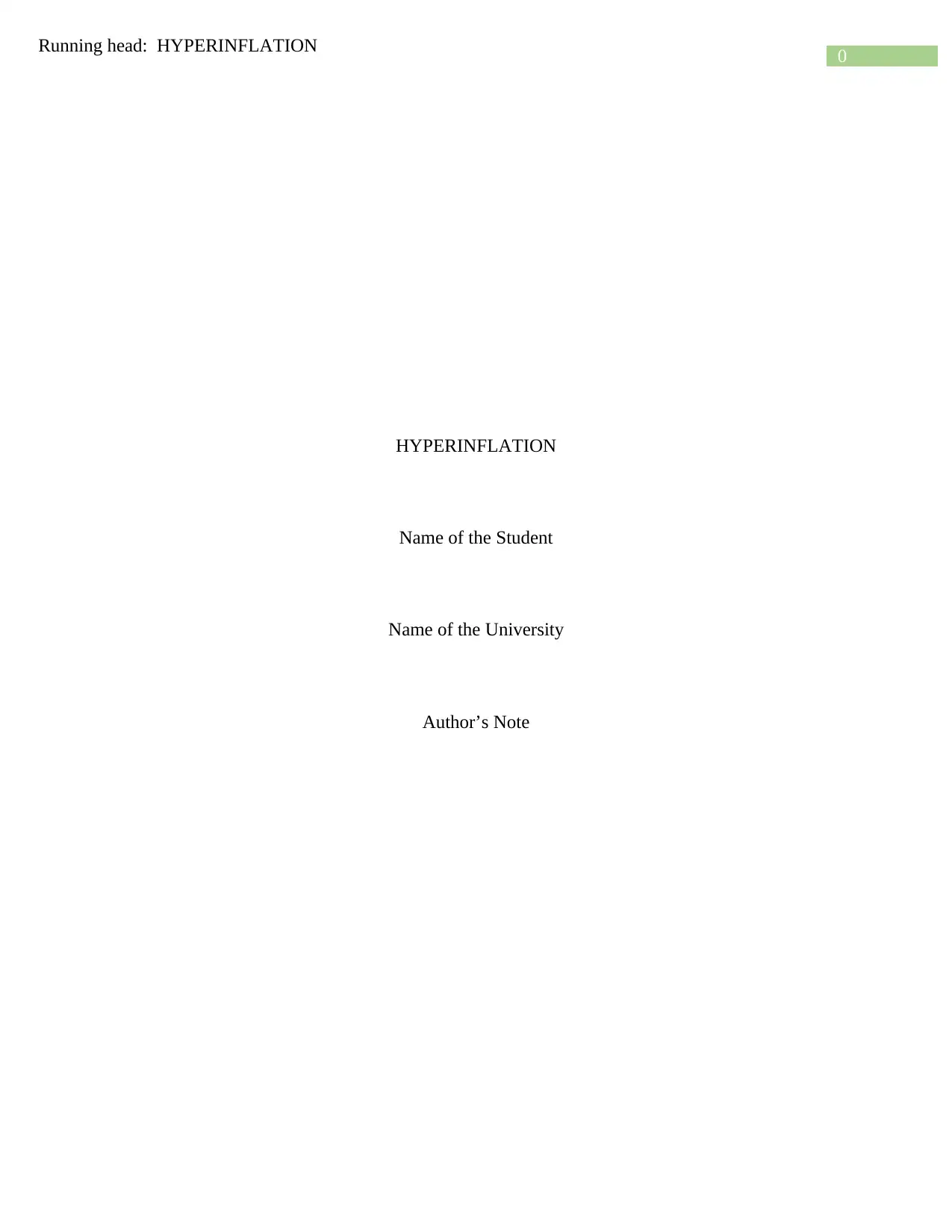
0
Running head: HYPERINFLATION
HYPERINFLATION
Name of the Student
Name of the University
Author’s Note
Running head: HYPERINFLATION
HYPERINFLATION
Name of the Student
Name of the University
Author’s Note
Secure Best Marks with AI Grader
Need help grading? Try our AI Grader for instant feedback on your assignments.
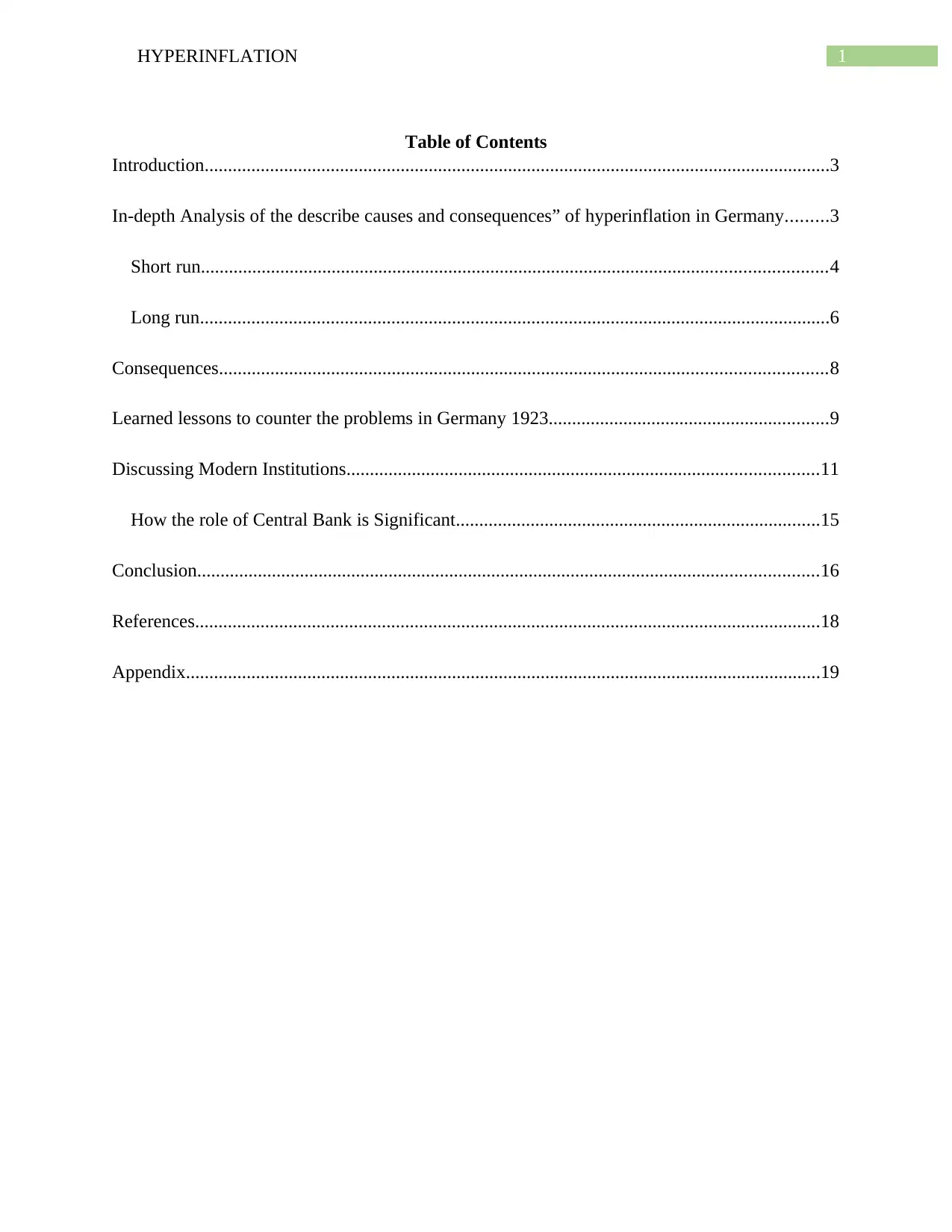
1HYPERINFLATION
Table of Contents
Introduction......................................................................................................................................3
In-depth Analysis of the describe causes and consequences” of hyperinflation in Germany.........3
Short run......................................................................................................................................4
Long run.......................................................................................................................................6
Consequences..................................................................................................................................8
Learned lessons to counter the problems in Germany 1923............................................................9
Discussing Modern Institutions.....................................................................................................11
How the role of Central Bank is Significant..............................................................................15
Conclusion.....................................................................................................................................16
References......................................................................................................................................18
Appendix........................................................................................................................................19
Table of Contents
Introduction......................................................................................................................................3
In-depth Analysis of the describe causes and consequences” of hyperinflation in Germany.........3
Short run......................................................................................................................................4
Long run.......................................................................................................................................6
Consequences..................................................................................................................................8
Learned lessons to counter the problems in Germany 1923............................................................9
Discussing Modern Institutions.....................................................................................................11
How the role of Central Bank is Significant..............................................................................15
Conclusion.....................................................................................................................................16
References......................................................................................................................................18
Appendix........................................................................................................................................19
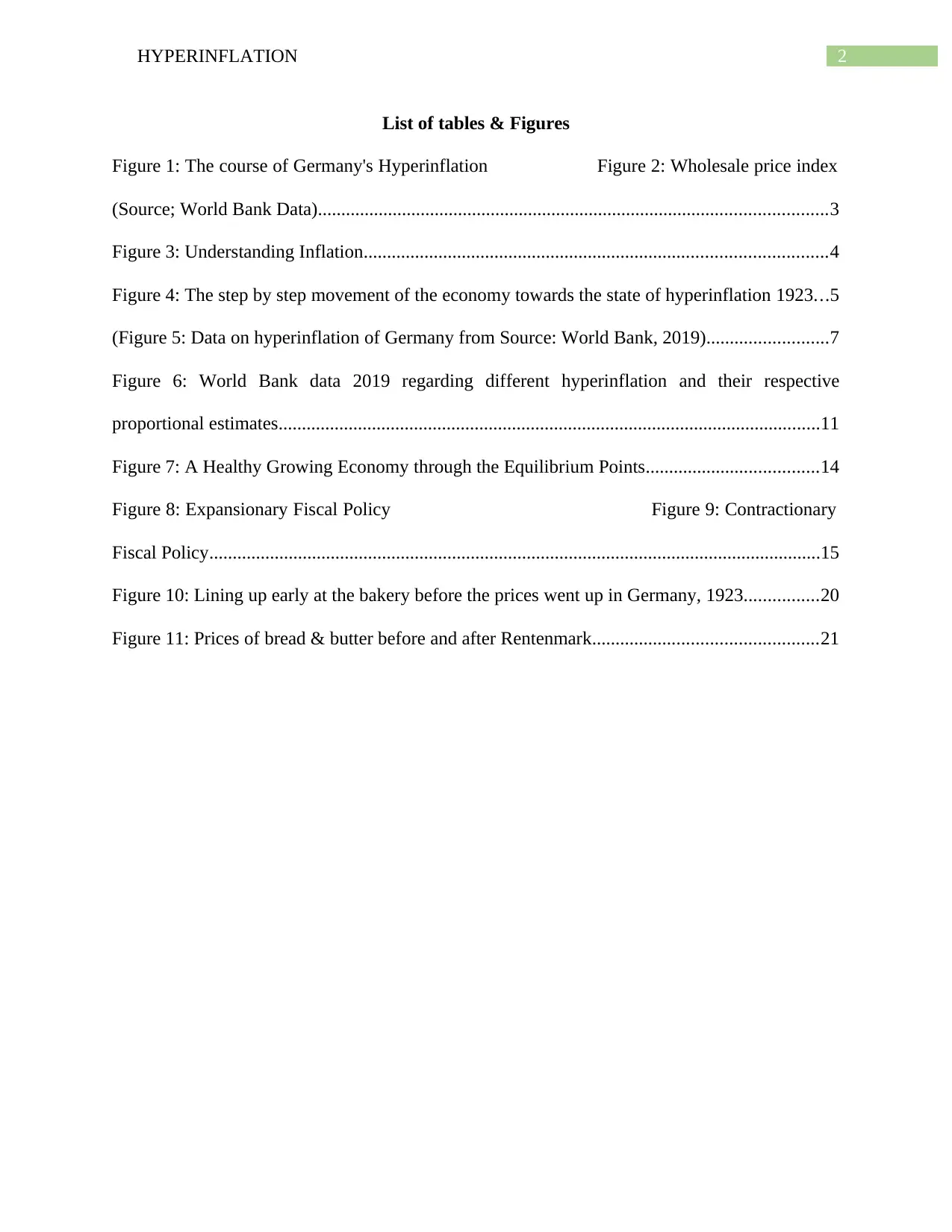
2HYPERINFLATION
List of tables & Figures
Figure 1: The course of Germany's Hyperinflation Figure 2: Wholesale price index
(Source; World Bank Data).............................................................................................................3
Figure 3: Understanding Inflation...................................................................................................4
Figure 4: The step by step movement of the economy towards the state of hyperinflation 1923...5
(Figure 5: Data on hyperinflation of Germany from Source: World Bank, 2019)..........................7
Figure 6: World Bank data 2019 regarding different hyperinflation and their respective
proportional estimates....................................................................................................................11
Figure 7: A Healthy Growing Economy through the Equilibrium Points.....................................14
Figure 8: Expansionary Fiscal Policy Figure 9: Contractionary
Fiscal Policy...................................................................................................................................15
Figure 10: Lining up early at the bakery before the prices went up in Germany, 1923................20
Figure 11: Prices of bread & butter before and after Rentenmark................................................21
List of tables & Figures
Figure 1: The course of Germany's Hyperinflation Figure 2: Wholesale price index
(Source; World Bank Data).............................................................................................................3
Figure 3: Understanding Inflation...................................................................................................4
Figure 4: The step by step movement of the economy towards the state of hyperinflation 1923...5
(Figure 5: Data on hyperinflation of Germany from Source: World Bank, 2019)..........................7
Figure 6: World Bank data 2019 regarding different hyperinflation and their respective
proportional estimates....................................................................................................................11
Figure 7: A Healthy Growing Economy through the Equilibrium Points.....................................14
Figure 8: Expansionary Fiscal Policy Figure 9: Contractionary
Fiscal Policy...................................................................................................................................15
Figure 10: Lining up early at the bakery before the prices went up in Germany, 1923................20
Figure 11: Prices of bread & butter before and after Rentenmark................................................21
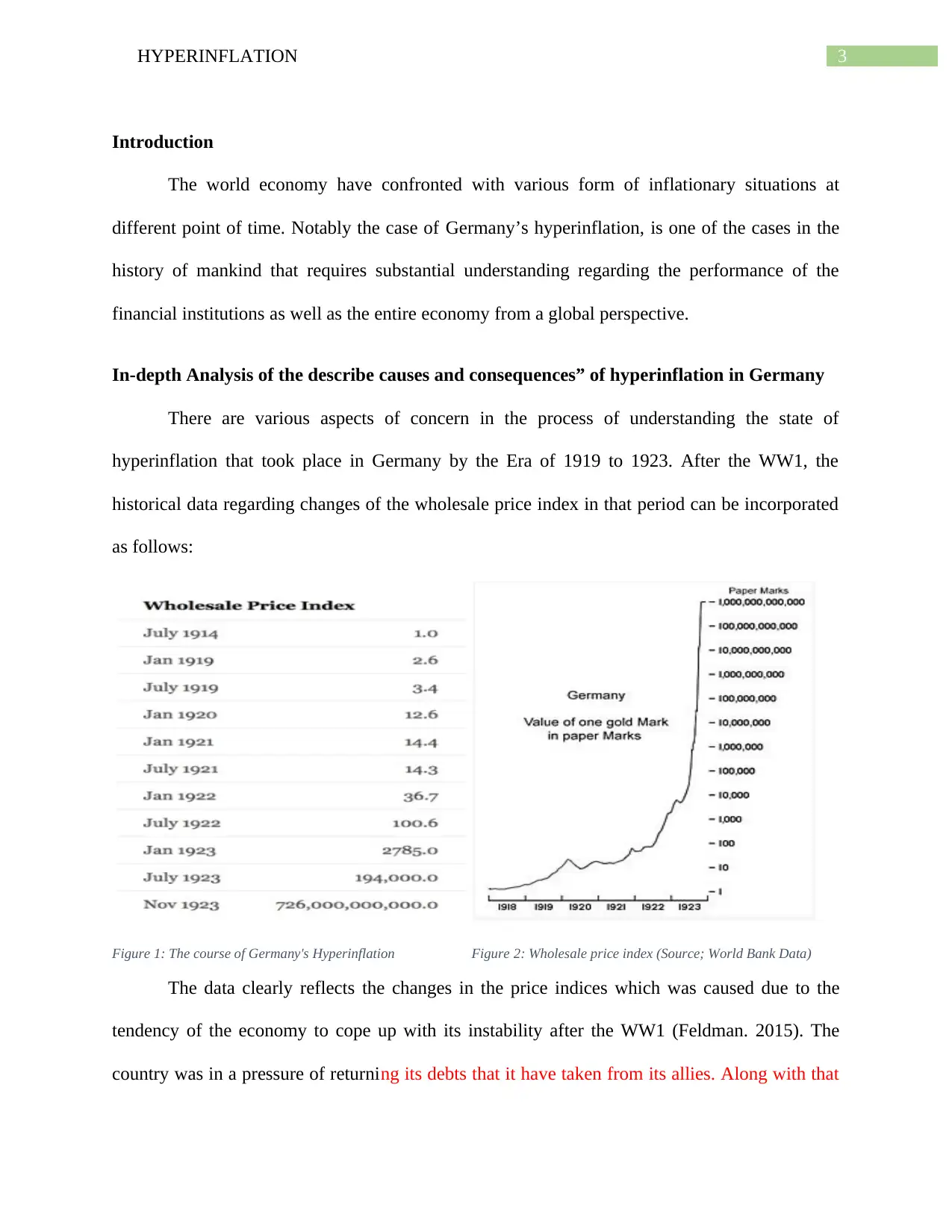
3HYPERINFLATION
Introduction
The world economy have confronted with various form of inflationary situations at
different point of time. Notably the case of Germany’s hyperinflation, is one of the cases in the
history of mankind that requires substantial understanding regarding the performance of the
financial institutions as well as the entire economy from a global perspective.
In-depth Analysis of the describe causes and consequences” of hyperinflation in Germany
There are various aspects of concern in the process of understanding the state of
hyperinflation that took place in Germany by the Era of 1919 to 1923. After the WW1, the
historical data regarding changes of the wholesale price index in that period can be incorporated
as follows:
Figure 1: The course of Germany's Hyperinflation Figure 2: Wholesale price index (Source; World Bank Data)
The data clearly reflects the changes in the price indices which was caused due to the
tendency of the economy to cope up with its instability after the WW1 (Feldman. 2015). The
country was in a pressure of returning its debts that it have taken from its allies. Along with that
Introduction
The world economy have confronted with various form of inflationary situations at
different point of time. Notably the case of Germany’s hyperinflation, is one of the cases in the
history of mankind that requires substantial understanding regarding the performance of the
financial institutions as well as the entire economy from a global perspective.
In-depth Analysis of the describe causes and consequences” of hyperinflation in Germany
There are various aspects of concern in the process of understanding the state of
hyperinflation that took place in Germany by the Era of 1919 to 1923. After the WW1, the
historical data regarding changes of the wholesale price index in that period can be incorporated
as follows:
Figure 1: The course of Germany's Hyperinflation Figure 2: Wholesale price index (Source; World Bank Data)
The data clearly reflects the changes in the price indices which was caused due to the
tendency of the economy to cope up with its instability after the WW1 (Feldman. 2015). The
country was in a pressure of returning its debts that it have taken from its allies. Along with that
Secure Best Marks with AI Grader
Need help grading? Try our AI Grader for instant feedback on your assignments.
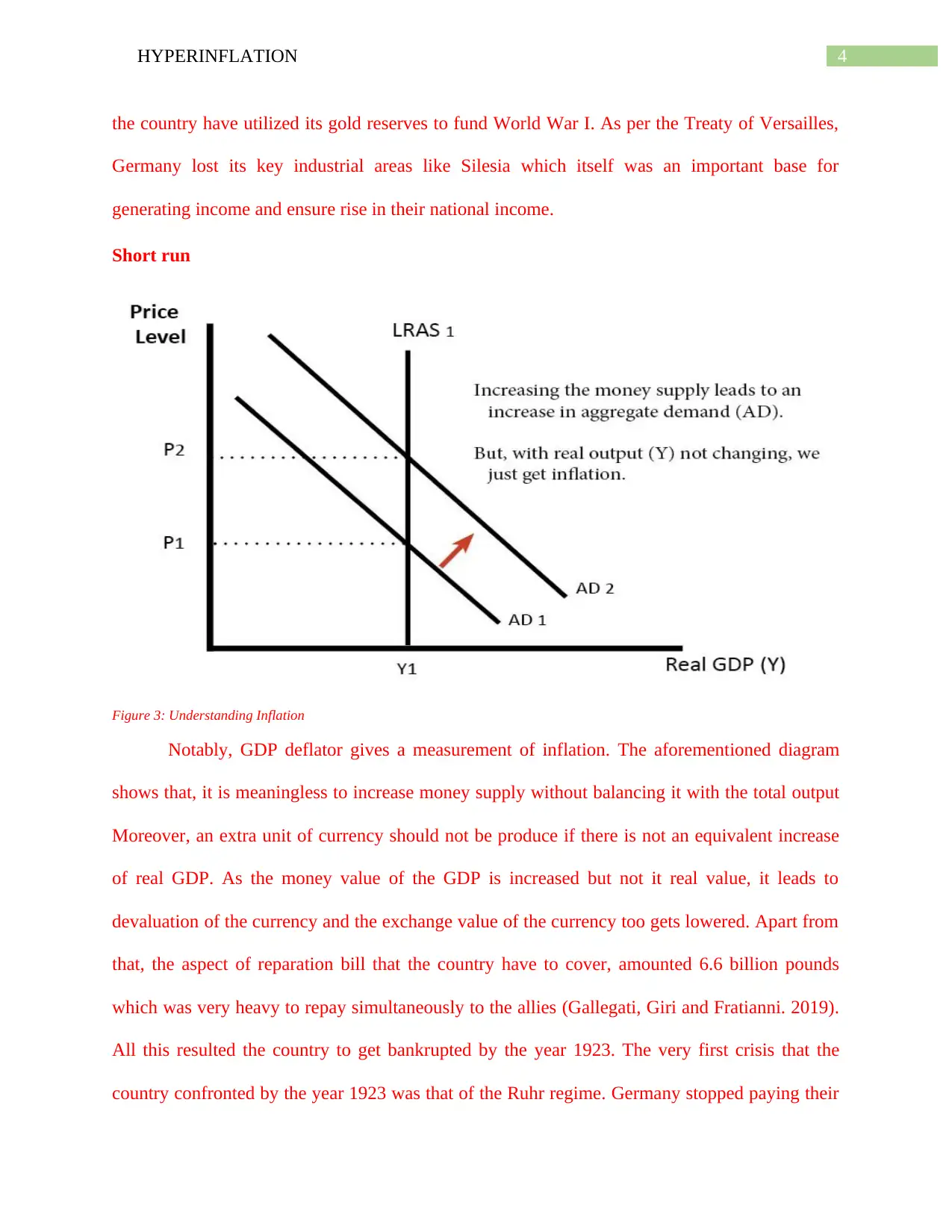
4HYPERINFLATION
the country have utilized its gold reserves to fund World War I. As per the Treaty of Versailles,
Germany lost its key industrial areas like Silesia which itself was an important base for
generating income and ensure rise in their national income.
Short run
Figure 3: Understanding Inflation
Notably, GDP deflator gives a measurement of inflation. The aforementioned diagram
shows that, it is meaningless to increase money supply without balancing it with the total output
Moreover, an extra unit of currency should not be produce if there is not an equivalent increase
of real GDP. As the money value of the GDP is increased but not it real value, it leads to
devaluation of the currency and the exchange value of the currency too gets lowered. Apart from
that, the aspect of reparation bill that the country have to cover, amounted 6.6 billion pounds
which was very heavy to repay simultaneously to the allies (Gallegati, Giri and Fratianni. 2019).
All this resulted the country to get bankrupted by the year 1923. The very first crisis that the
country confronted by the year 1923 was that of the Ruhr regime. Germany stopped paying their
the country have utilized its gold reserves to fund World War I. As per the Treaty of Versailles,
Germany lost its key industrial areas like Silesia which itself was an important base for
generating income and ensure rise in their national income.
Short run
Figure 3: Understanding Inflation
Notably, GDP deflator gives a measurement of inflation. The aforementioned diagram
shows that, it is meaningless to increase money supply without balancing it with the total output
Moreover, an extra unit of currency should not be produce if there is not an equivalent increase
of real GDP. As the money value of the GDP is increased but not it real value, it leads to
devaluation of the currency and the exchange value of the currency too gets lowered. Apart from
that, the aspect of reparation bill that the country have to cover, amounted 6.6 billion pounds
which was very heavy to repay simultaneously to the allies (Gallegati, Giri and Fratianni. 2019).
All this resulted the country to get bankrupted by the year 1923. The very first crisis that the
country confronted by the year 1923 was that of the Ruhr regime. Germany stopped paying their
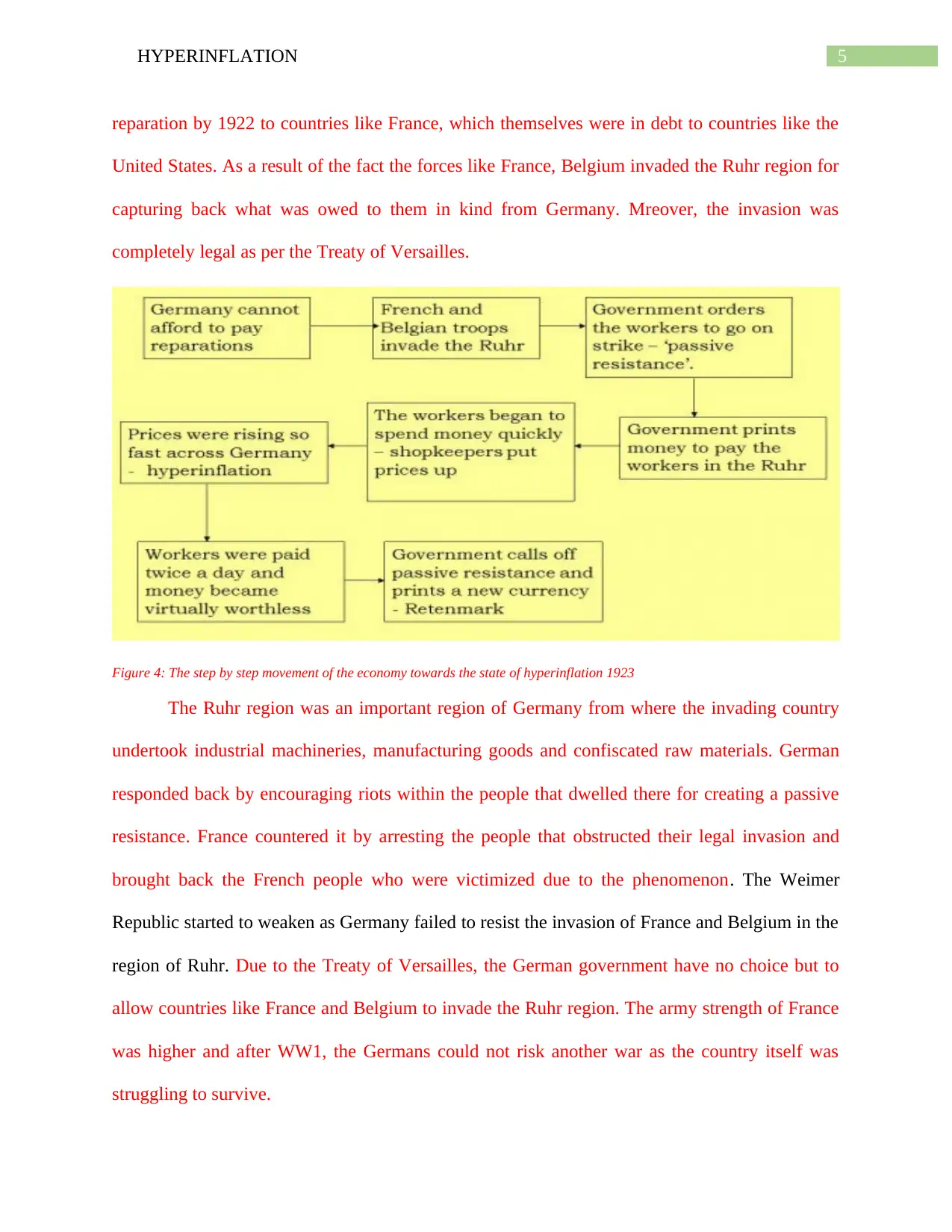
5HYPERINFLATION
reparation by 1922 to countries like France, which themselves were in debt to countries like the
United States. As a result of the fact the forces like France, Belgium invaded the Ruhr region for
capturing back what was owed to them in kind from Germany. Mreover, the invasion was
completely legal as per the Treaty of Versailles.
Figure 4: The step by step movement of the economy towards the state of hyperinflation 1923
The Ruhr region was an important region of Germany from where the invading country
undertook industrial machineries, manufacturing goods and confiscated raw materials. German
responded back by encouraging riots within the people that dwelled there for creating a passive
resistance. France countered it by arresting the people that obstructed their legal invasion and
brought back the French people who were victimized due to the phenomenon. The Weimer
Republic started to weaken as Germany failed to resist the invasion of France and Belgium in the
region of Ruhr. Due to the Treaty of Versailles, the German government have no choice but to
allow countries like France and Belgium to invade the Ruhr region. The army strength of France
was higher and after WW1, the Germans could not risk another war as the country itself was
struggling to survive.
reparation by 1922 to countries like France, which themselves were in debt to countries like the
United States. As a result of the fact the forces like France, Belgium invaded the Ruhr region for
capturing back what was owed to them in kind from Germany. Mreover, the invasion was
completely legal as per the Treaty of Versailles.
Figure 4: The step by step movement of the economy towards the state of hyperinflation 1923
The Ruhr region was an important region of Germany from where the invading country
undertook industrial machineries, manufacturing goods and confiscated raw materials. German
responded back by encouraging riots within the people that dwelled there for creating a passive
resistance. France countered it by arresting the people that obstructed their legal invasion and
brought back the French people who were victimized due to the phenomenon. The Weimer
Republic started to weaken as Germany failed to resist the invasion of France and Belgium in the
region of Ruhr. Due to the Treaty of Versailles, the German government have no choice but to
allow countries like France and Belgium to invade the Ruhr region. The army strength of France
was higher and after WW1, the Germans could not risk another war as the country itself was
struggling to survive.
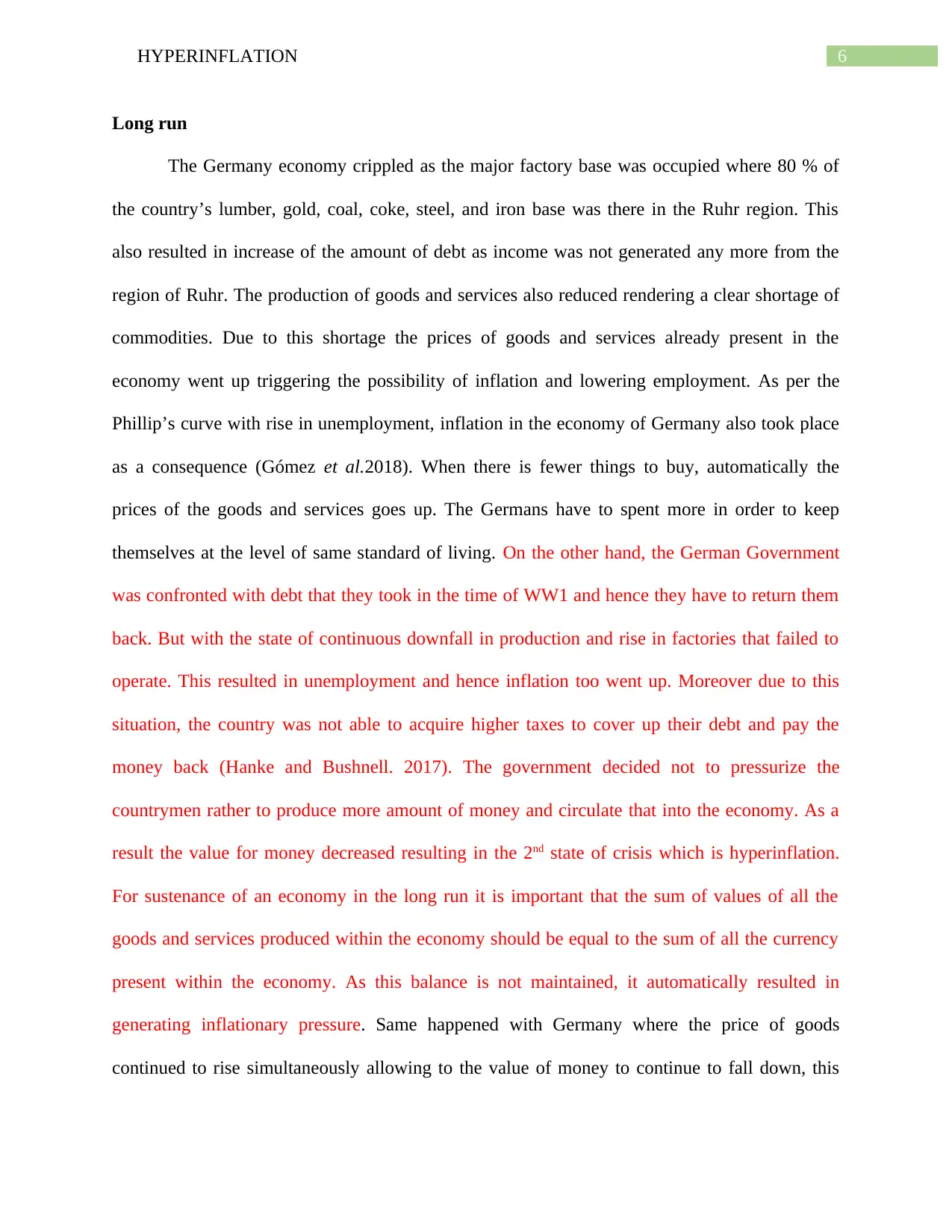
6HYPERINFLATION
Long run
The Germany economy crippled as the major factory base was occupied where 80 % of
the country’s lumber, gold, coal, coke, steel, and iron base was there in the Ruhr region. This
also resulted in increase of the amount of debt as income was not generated any more from the
region of Ruhr. The production of goods and services also reduced rendering a clear shortage of
commodities. Due to this shortage the prices of goods and services already present in the
economy went up triggering the possibility of inflation and lowering employment. As per the
Phillip’s curve with rise in unemployment, inflation in the economy of Germany also took place
as a consequence (Gómez et al.2018). When there is fewer things to buy, automatically the
prices of the goods and services goes up. The Germans have to spent more in order to keep
themselves at the level of same standard of living. On the other hand, the German Government
was confronted with debt that they took in the time of WW1 and hence they have to return them
back. But with the state of continuous downfall in production and rise in factories that failed to
operate. This resulted in unemployment and hence inflation too went up. Moreover due to this
situation, the country was not able to acquire higher taxes to cover up their debt and pay the
money back (Hanke and Bushnell. 2017). The government decided not to pressurize the
countrymen rather to produce more amount of money and circulate that into the economy. As a
result the value for money decreased resulting in the 2nd state of crisis which is hyperinflation.
For sustenance of an economy in the long run it is important that the sum of values of all the
goods and services produced within the economy should be equal to the sum of all the currency
present within the economy. As this balance is not maintained, it automatically resulted in
generating inflationary pressure. Same happened with Germany where the price of goods
continued to rise simultaneously allowing to the value of money to continue to fall down, this
Long run
The Germany economy crippled as the major factory base was occupied where 80 % of
the country’s lumber, gold, coal, coke, steel, and iron base was there in the Ruhr region. This
also resulted in increase of the amount of debt as income was not generated any more from the
region of Ruhr. The production of goods and services also reduced rendering a clear shortage of
commodities. Due to this shortage the prices of goods and services already present in the
economy went up triggering the possibility of inflation and lowering employment. As per the
Phillip’s curve with rise in unemployment, inflation in the economy of Germany also took place
as a consequence (Gómez et al.2018). When there is fewer things to buy, automatically the
prices of the goods and services goes up. The Germans have to spent more in order to keep
themselves at the level of same standard of living. On the other hand, the German Government
was confronted with debt that they took in the time of WW1 and hence they have to return them
back. But with the state of continuous downfall in production and rise in factories that failed to
operate. This resulted in unemployment and hence inflation too went up. Moreover due to this
situation, the country was not able to acquire higher taxes to cover up their debt and pay the
money back (Hanke and Bushnell. 2017). The government decided not to pressurize the
countrymen rather to produce more amount of money and circulate that into the economy. As a
result the value for money decreased resulting in the 2nd state of crisis which is hyperinflation.
For sustenance of an economy in the long run it is important that the sum of values of all the
goods and services produced within the economy should be equal to the sum of all the currency
present within the economy. As this balance is not maintained, it automatically resulted in
generating inflationary pressure. Same happened with Germany where the price of goods
continued to rise simultaneously allowing to the value of money to continue to fall down, this
Paraphrase This Document
Need a fresh take? Get an instant paraphrase of this document with our AI Paraphraser
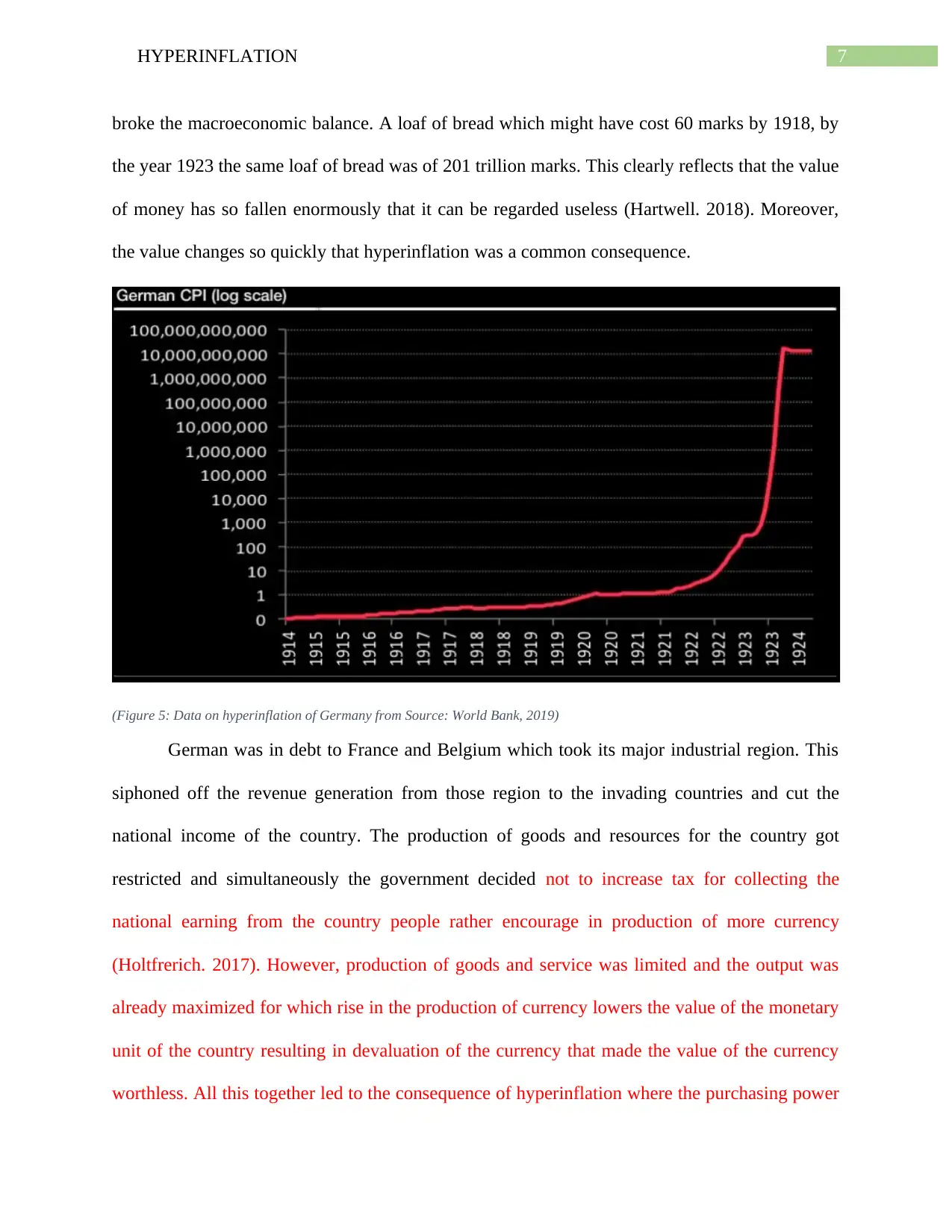
7HYPERINFLATION
broke the macroeconomic balance. A loaf of bread which might have cost 60 marks by 1918, by
the year 1923 the same loaf of bread was of 201 trillion marks. This clearly reflects that the value
of money has so fallen enormously that it can be regarded useless (Hartwell. 2018). Moreover,
the value changes so quickly that hyperinflation was a common consequence.
(Figure 5: Data on hyperinflation of Germany from Source: World Bank, 2019)
German was in debt to France and Belgium which took its major industrial region. This
siphoned off the revenue generation from those region to the invading countries and cut the
national income of the country. The production of goods and resources for the country got
restricted and simultaneously the government decided not to increase tax for collecting the
national earning from the country people rather encourage in production of more currency
(Holtfrerich. 2017). However, production of goods and service was limited and the output was
already maximized for which rise in the production of currency lowers the value of the monetary
unit of the country resulting in devaluation of the currency that made the value of the currency
worthless. All this together led to the consequence of hyperinflation where the purchasing power
broke the macroeconomic balance. A loaf of bread which might have cost 60 marks by 1918, by
the year 1923 the same loaf of bread was of 201 trillion marks. This clearly reflects that the value
of money has so fallen enormously that it can be regarded useless (Hartwell. 2018). Moreover,
the value changes so quickly that hyperinflation was a common consequence.
(Figure 5: Data on hyperinflation of Germany from Source: World Bank, 2019)
German was in debt to France and Belgium which took its major industrial region. This
siphoned off the revenue generation from those region to the invading countries and cut the
national income of the country. The production of goods and resources for the country got
restricted and simultaneously the government decided not to increase tax for collecting the
national earning from the country people rather encourage in production of more currency
(Holtfrerich. 2017). However, production of goods and service was limited and the output was
already maximized for which rise in the production of currency lowers the value of the monetary
unit of the country resulting in devaluation of the currency that made the value of the currency
worthless. All this together led to the consequence of hyperinflation where the purchasing power
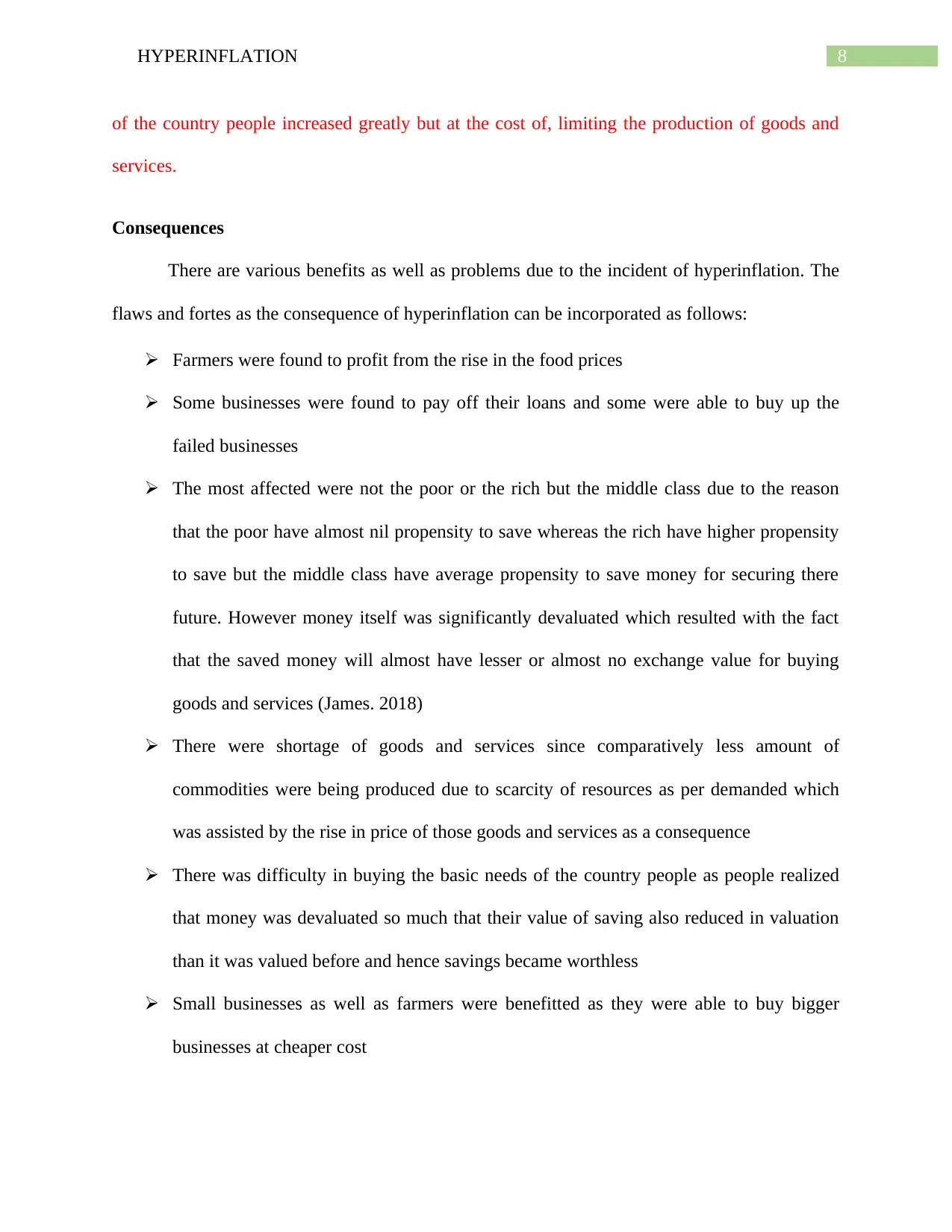
8HYPERINFLATION
of the country people increased greatly but at the cost of, limiting the production of goods and
services.
Consequences
There are various benefits as well as problems due to the incident of hyperinflation. The
flaws and fortes as the consequence of hyperinflation can be incorporated as follows:
Farmers were found to profit from the rise in the food prices
Some businesses were found to pay off their loans and some were able to buy up the
failed businesses
The most affected were not the poor or the rich but the middle class due to the reason
that the poor have almost nil propensity to save whereas the rich have higher propensity
to save but the middle class have average propensity to save money for securing there
future. However money itself was significantly devaluated which resulted with the fact
that the saved money will almost have lesser or almost no exchange value for buying
goods and services (James. 2018)
There were shortage of goods and services since comparatively less amount of
commodities were being produced due to scarcity of resources as per demanded which
was assisted by the rise in price of those goods and services as a consequence
There was difficulty in buying the basic needs of the country people as people realized
that money was devaluated so much that their value of saving also reduced in valuation
than it was valued before and hence savings became worthless
Small businesses as well as farmers were benefitted as they were able to buy bigger
businesses at cheaper cost
of the country people increased greatly but at the cost of, limiting the production of goods and
services.
Consequences
There are various benefits as well as problems due to the incident of hyperinflation. The
flaws and fortes as the consequence of hyperinflation can be incorporated as follows:
Farmers were found to profit from the rise in the food prices
Some businesses were found to pay off their loans and some were able to buy up the
failed businesses
The most affected were not the poor or the rich but the middle class due to the reason
that the poor have almost nil propensity to save whereas the rich have higher propensity
to save but the middle class have average propensity to save money for securing there
future. However money itself was significantly devaluated which resulted with the fact
that the saved money will almost have lesser or almost no exchange value for buying
goods and services (James. 2018)
There were shortage of goods and services since comparatively less amount of
commodities were being produced due to scarcity of resources as per demanded which
was assisted by the rise in price of those goods and services as a consequence
There was difficulty in buying the basic needs of the country people as people realized
that money was devaluated so much that their value of saving also reduced in valuation
than it was valued before and hence savings became worthless
Small businesses as well as farmers were benefitted as they were able to buy bigger
businesses at cheaper cost
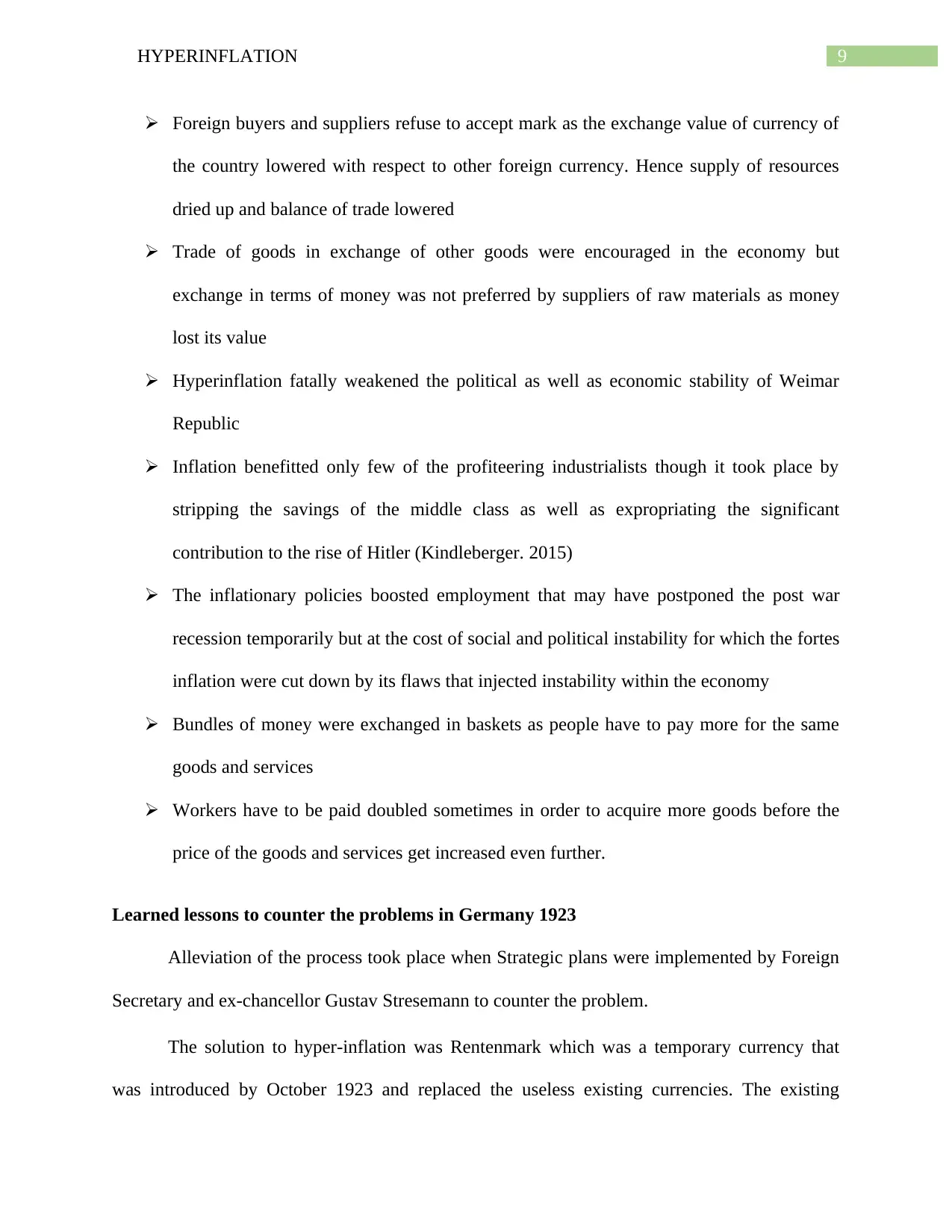
9HYPERINFLATION
Foreign buyers and suppliers refuse to accept mark as the exchange value of currency of
the country lowered with respect to other foreign currency. Hence supply of resources
dried up and balance of trade lowered
Trade of goods in exchange of other goods were encouraged in the economy but
exchange in terms of money was not preferred by suppliers of raw materials as money
lost its value
Hyperinflation fatally weakened the political as well as economic stability of Weimar
Republic
Inflation benefitted only few of the profiteering industrialists though it took place by
stripping the savings of the middle class as well as expropriating the significant
contribution to the rise of Hitler (Kindleberger. 2015)
The inflationary policies boosted employment that may have postponed the post war
recession temporarily but at the cost of social and political instability for which the fortes
inflation were cut down by its flaws that injected instability within the economy
Bundles of money were exchanged in baskets as people have to pay more for the same
goods and services
Workers have to be paid doubled sometimes in order to acquire more goods before the
price of the goods and services get increased even further.
Learned lessons to counter the problems in Germany 1923
Alleviation of the process took place when Strategic plans were implemented by Foreign
Secretary and ex-chancellor Gustav Stresemann to counter the problem.
The solution to hyper-inflation was Rentenmark which was a temporary currency that
was introduced by October 1923 and replaced the useless existing currencies. The existing
Foreign buyers and suppliers refuse to accept mark as the exchange value of currency of
the country lowered with respect to other foreign currency. Hence supply of resources
dried up and balance of trade lowered
Trade of goods in exchange of other goods were encouraged in the economy but
exchange in terms of money was not preferred by suppliers of raw materials as money
lost its value
Hyperinflation fatally weakened the political as well as economic stability of Weimar
Republic
Inflation benefitted only few of the profiteering industrialists though it took place by
stripping the savings of the middle class as well as expropriating the significant
contribution to the rise of Hitler (Kindleberger. 2015)
The inflationary policies boosted employment that may have postponed the post war
recession temporarily but at the cost of social and political instability for which the fortes
inflation were cut down by its flaws that injected instability within the economy
Bundles of money were exchanged in baskets as people have to pay more for the same
goods and services
Workers have to be paid doubled sometimes in order to acquire more goods before the
price of the goods and services get increased even further.
Learned lessons to counter the problems in Germany 1923
Alleviation of the process took place when Strategic plans were implemented by Foreign
Secretary and ex-chancellor Gustav Stresemann to counter the problem.
The solution to hyper-inflation was Rentenmark which was a temporary currency that
was introduced by October 1923 and replaced the useless existing currencies. The existing
Secure Best Marks with AI Grader
Need help grading? Try our AI Grader for instant feedback on your assignments.
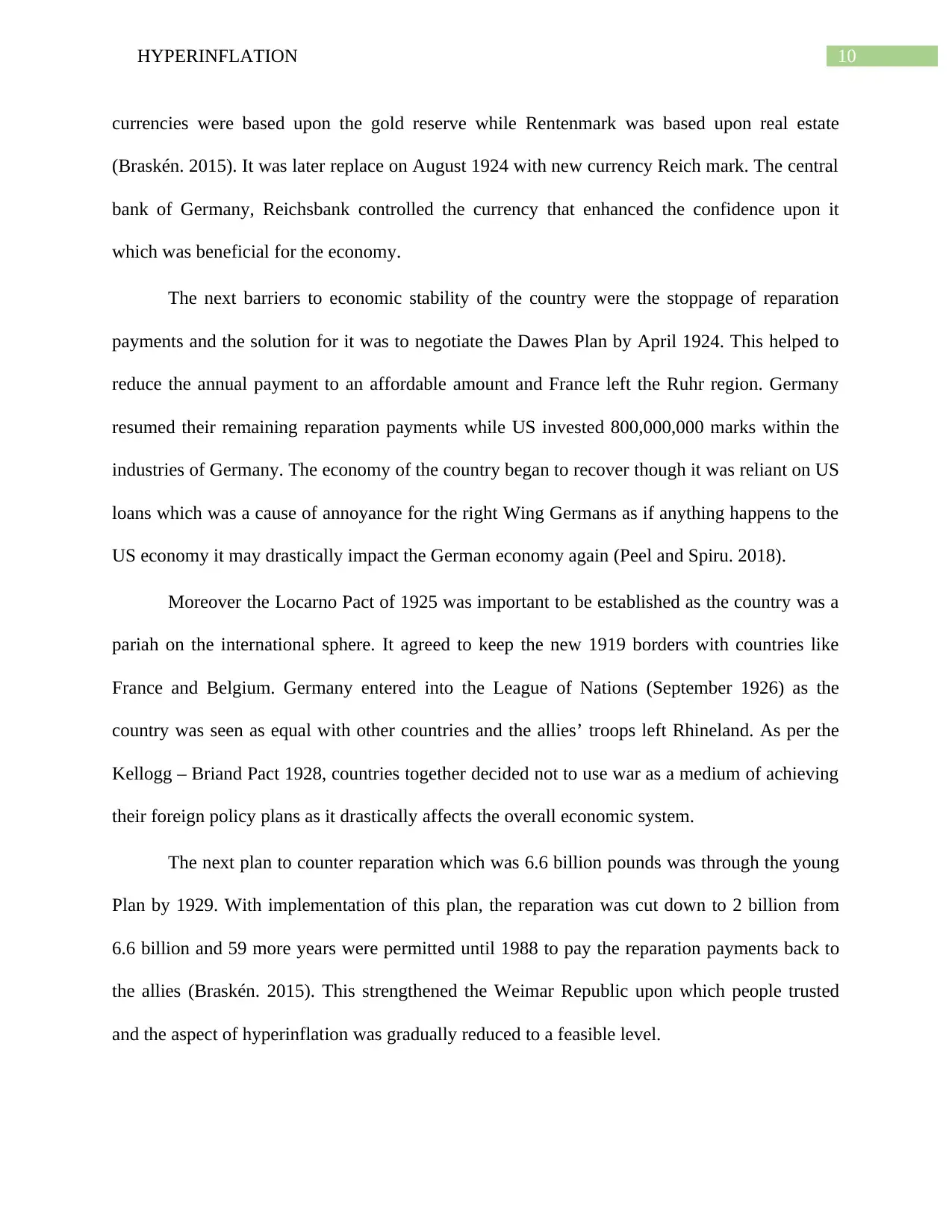
10HYPERINFLATION
currencies were based upon the gold reserve while Rentenmark was based upon real estate
(Braskén. 2015). It was later replace on August 1924 with new currency Reich mark. The central
bank of Germany, Reichsbank controlled the currency that enhanced the confidence upon it
which was beneficial for the economy.
The next barriers to economic stability of the country were the stoppage of reparation
payments and the solution for it was to negotiate the Dawes Plan by April 1924. This helped to
reduce the annual payment to an affordable amount and France left the Ruhr region. Germany
resumed their remaining reparation payments while US invested 800,000,000 marks within the
industries of Germany. The economy of the country began to recover though it was reliant on US
loans which was a cause of annoyance for the right Wing Germans as if anything happens to the
US economy it may drastically impact the German economy again (Peel and Spiru. 2018).
Moreover the Locarno Pact of 1925 was important to be established as the country was a
pariah on the international sphere. It agreed to keep the new 1919 borders with countries like
France and Belgium. Germany entered into the League of Nations (September 1926) as the
country was seen as equal with other countries and the allies’ troops left Rhineland. As per the
Kellogg – Briand Pact 1928, countries together decided not to use war as a medium of achieving
their foreign policy plans as it drastically affects the overall economic system.
The next plan to counter reparation which was 6.6 billion pounds was through the young
Plan by 1929. With implementation of this plan, the reparation was cut down to 2 billion from
6.6 billion and 59 more years were permitted until 1988 to pay the reparation payments back to
the allies (Braskén. 2015). This strengthened the Weimar Republic upon which people trusted
and the aspect of hyperinflation was gradually reduced to a feasible level.
currencies were based upon the gold reserve while Rentenmark was based upon real estate
(Braskén. 2015). It was later replace on August 1924 with new currency Reich mark. The central
bank of Germany, Reichsbank controlled the currency that enhanced the confidence upon it
which was beneficial for the economy.
The next barriers to economic stability of the country were the stoppage of reparation
payments and the solution for it was to negotiate the Dawes Plan by April 1924. This helped to
reduce the annual payment to an affordable amount and France left the Ruhr region. Germany
resumed their remaining reparation payments while US invested 800,000,000 marks within the
industries of Germany. The economy of the country began to recover though it was reliant on US
loans which was a cause of annoyance for the right Wing Germans as if anything happens to the
US economy it may drastically impact the German economy again (Peel and Spiru. 2018).
Moreover the Locarno Pact of 1925 was important to be established as the country was a
pariah on the international sphere. It agreed to keep the new 1919 borders with countries like
France and Belgium. Germany entered into the League of Nations (September 1926) as the
country was seen as equal with other countries and the allies’ troops left Rhineland. As per the
Kellogg – Briand Pact 1928, countries together decided not to use war as a medium of achieving
their foreign policy plans as it drastically affects the overall economic system.
The next plan to counter reparation which was 6.6 billion pounds was through the young
Plan by 1929. With implementation of this plan, the reparation was cut down to 2 billion from
6.6 billion and 59 more years were permitted until 1988 to pay the reparation payments back to
the allies (Braskén. 2015). This strengthened the Weimar Republic upon which people trusted
and the aspect of hyperinflation was gradually reduced to a feasible level.
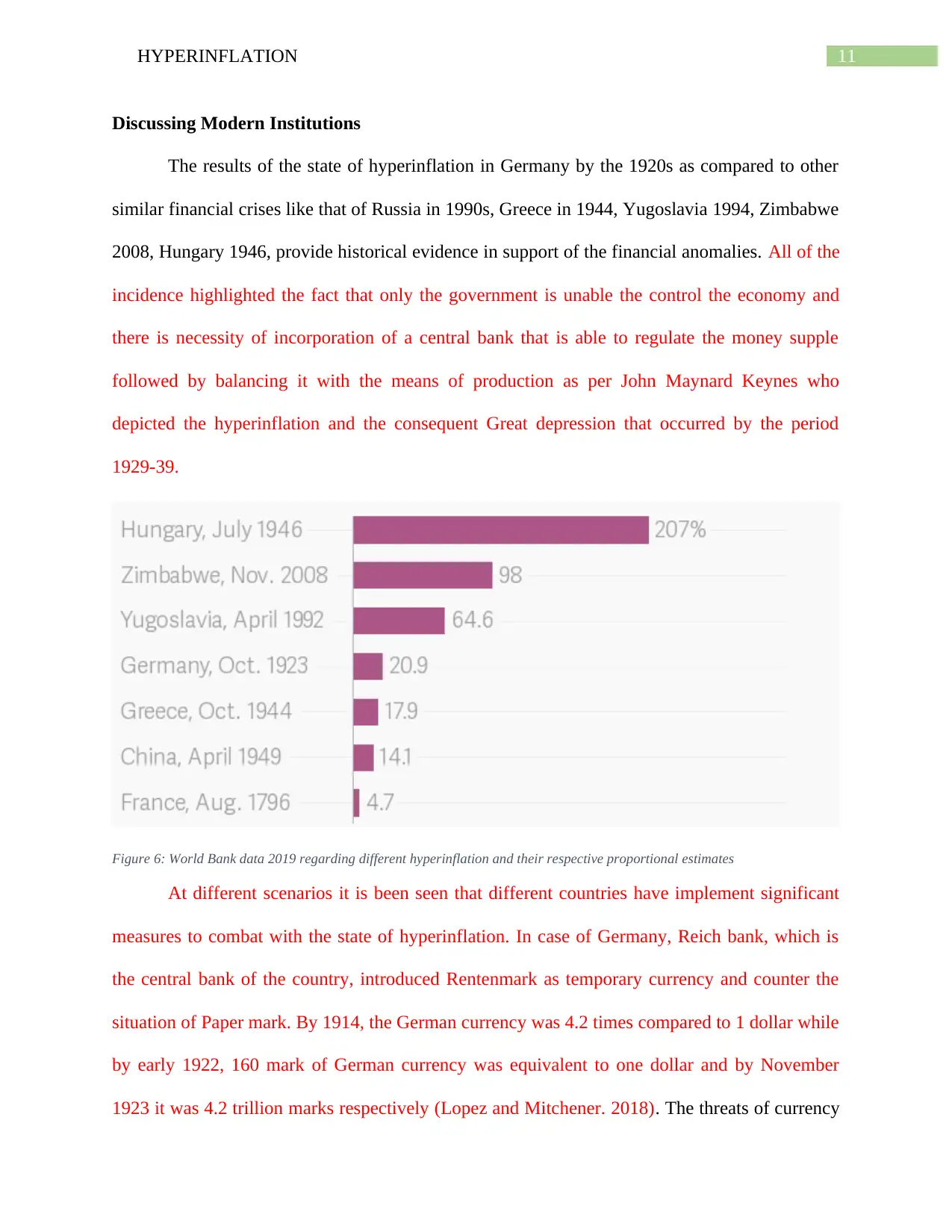
11HYPERINFLATION
Discussing Modern Institutions
The results of the state of hyperinflation in Germany by the 1920s as compared to other
similar financial crises like that of Russia in 1990s, Greece in 1944, Yugoslavia 1994, Zimbabwe
2008, Hungary 1946, provide historical evidence in support of the financial anomalies. All of the
incidence highlighted the fact that only the government is unable the control the economy and
there is necessity of incorporation of a central bank that is able to regulate the money supple
followed by balancing it with the means of production as per John Maynard Keynes who
depicted the hyperinflation and the consequent Great depression that occurred by the period
1929-39.
Figure 6: World Bank data 2019 regarding different hyperinflation and their respective proportional estimates
At different scenarios it is been seen that different countries have implement significant
measures to combat with the state of hyperinflation. In case of Germany, Reich bank, which is
the central bank of the country, introduced Rentenmark as temporary currency and counter the
situation of Paper mark. By 1914, the German currency was 4.2 times compared to 1 dollar while
by early 1922, 160 mark of German currency was equivalent to one dollar and by November
1923 it was 4.2 trillion marks respectively (Lopez and Mitchener. 2018). The threats of currency
Discussing Modern Institutions
The results of the state of hyperinflation in Germany by the 1920s as compared to other
similar financial crises like that of Russia in 1990s, Greece in 1944, Yugoslavia 1994, Zimbabwe
2008, Hungary 1946, provide historical evidence in support of the financial anomalies. All of the
incidence highlighted the fact that only the government is unable the control the economy and
there is necessity of incorporation of a central bank that is able to regulate the money supple
followed by balancing it with the means of production as per John Maynard Keynes who
depicted the hyperinflation and the consequent Great depression that occurred by the period
1929-39.
Figure 6: World Bank data 2019 regarding different hyperinflation and their respective proportional estimates
At different scenarios it is been seen that different countries have implement significant
measures to combat with the state of hyperinflation. In case of Germany, Reich bank, which is
the central bank of the country, introduced Rentenmark as temporary currency and counter the
situation of Paper mark. By 1914, the German currency was 4.2 times compared to 1 dollar while
by early 1922, 160 mark of German currency was equivalent to one dollar and by November
1923 it was 4.2 trillion marks respectively (Lopez and Mitchener. 2018). The threats of currency
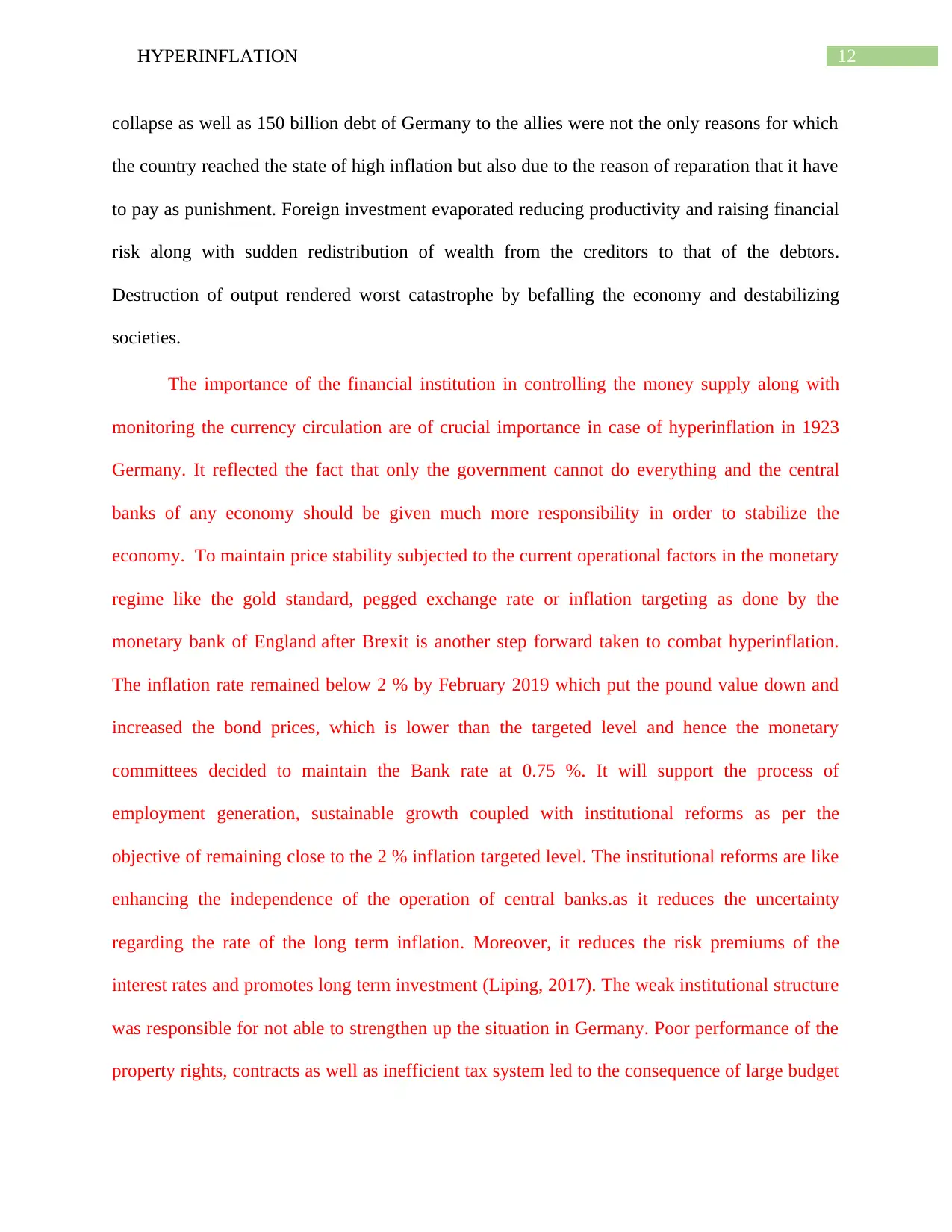
12HYPERINFLATION
collapse as well as 150 billion debt of Germany to the allies were not the only reasons for which
the country reached the state of high inflation but also due to the reason of reparation that it have
to pay as punishment. Foreign investment evaporated reducing productivity and raising financial
risk along with sudden redistribution of wealth from the creditors to that of the debtors.
Destruction of output rendered worst catastrophe by befalling the economy and destabilizing
societies.
The importance of the financial institution in controlling the money supply along with
monitoring the currency circulation are of crucial importance in case of hyperinflation in 1923
Germany. It reflected the fact that only the government cannot do everything and the central
banks of any economy should be given much more responsibility in order to stabilize the
economy. To maintain price stability subjected to the current operational factors in the monetary
regime like the gold standard, pegged exchange rate or inflation targeting as done by the
monetary bank of England after Brexit is another step forward taken to combat hyperinflation.
The inflation rate remained below 2 % by February 2019 which put the pound value down and
increased the bond prices, which is lower than the targeted level and hence the monetary
committees decided to maintain the Bank rate at 0.75 %. It will support the process of
employment generation, sustainable growth coupled with institutional reforms as per the
objective of remaining close to the 2 % inflation targeted level. The institutional reforms are like
enhancing the independence of the operation of central banks.as it reduces the uncertainty
regarding the rate of the long term inflation. Moreover, it reduces the risk premiums of the
interest rates and promotes long term investment (Liping, 2017). The weak institutional structure
was responsible for not able to strengthen up the situation in Germany. Poor performance of the
property rights, contracts as well as inefficient tax system led to the consequence of large budget
collapse as well as 150 billion debt of Germany to the allies were not the only reasons for which
the country reached the state of high inflation but also due to the reason of reparation that it have
to pay as punishment. Foreign investment evaporated reducing productivity and raising financial
risk along with sudden redistribution of wealth from the creditors to that of the debtors.
Destruction of output rendered worst catastrophe by befalling the economy and destabilizing
societies.
The importance of the financial institution in controlling the money supply along with
monitoring the currency circulation are of crucial importance in case of hyperinflation in 1923
Germany. It reflected the fact that only the government cannot do everything and the central
banks of any economy should be given much more responsibility in order to stabilize the
economy. To maintain price stability subjected to the current operational factors in the monetary
regime like the gold standard, pegged exchange rate or inflation targeting as done by the
monetary bank of England after Brexit is another step forward taken to combat hyperinflation.
The inflation rate remained below 2 % by February 2019 which put the pound value down and
increased the bond prices, which is lower than the targeted level and hence the monetary
committees decided to maintain the Bank rate at 0.75 %. It will support the process of
employment generation, sustainable growth coupled with institutional reforms as per the
objective of remaining close to the 2 % inflation targeted level. The institutional reforms are like
enhancing the independence of the operation of central banks.as it reduces the uncertainty
regarding the rate of the long term inflation. Moreover, it reduces the risk premiums of the
interest rates and promotes long term investment (Liping, 2017). The weak institutional structure
was responsible for not able to strengthen up the situation in Germany. Poor performance of the
property rights, contracts as well as inefficient tax system led to the consequence of large budget
Paraphrase This Document
Need a fresh take? Get an instant paraphrase of this document with our AI Paraphraser
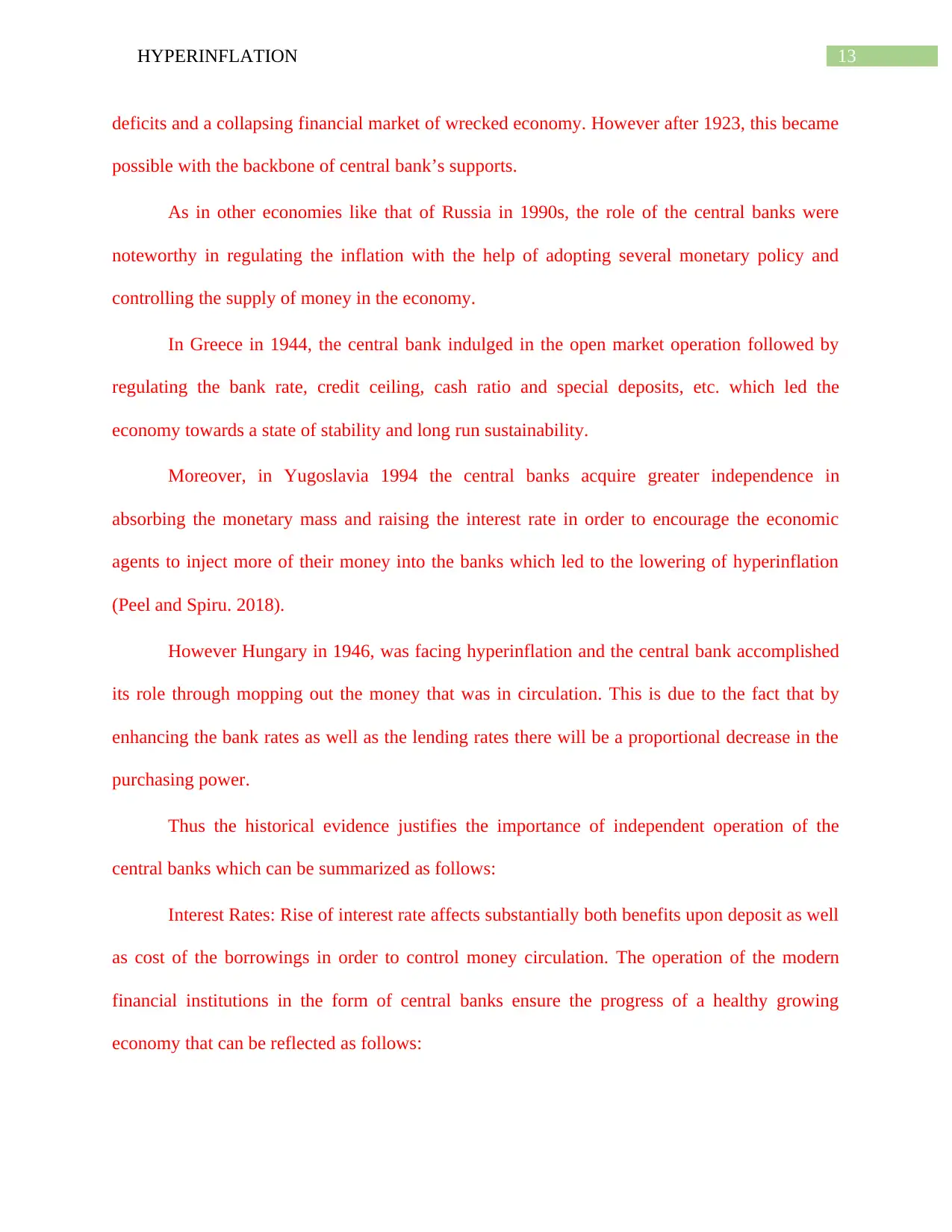
13HYPERINFLATION
deficits and a collapsing financial market of wrecked economy. However after 1923, this became
possible with the backbone of central bank’s supports.
As in other economies like that of Russia in 1990s, the role of the central banks were
noteworthy in regulating the inflation with the help of adopting several monetary policy and
controlling the supply of money in the economy.
In Greece in 1944, the central bank indulged in the open market operation followed by
regulating the bank rate, credit ceiling, cash ratio and special deposits, etc. which led the
economy towards a state of stability and long run sustainability.
Moreover, in Yugoslavia 1994 the central banks acquire greater independence in
absorbing the monetary mass and raising the interest rate in order to encourage the economic
agents to inject more of their money into the banks which led to the lowering of hyperinflation
(Peel and Spiru. 2018).
However Hungary in 1946, was facing hyperinflation and the central bank accomplished
its role through mopping out the money that was in circulation. This is due to the fact that by
enhancing the bank rates as well as the lending rates there will be a proportional decrease in the
purchasing power.
Thus the historical evidence justifies the importance of independent operation of the
central banks which can be summarized as follows:
Interest Rates: Rise of interest rate affects substantially both benefits upon deposit as well
as cost of the borrowings in order to control money circulation. The operation of the modern
financial institutions in the form of central banks ensure the progress of a healthy growing
economy that can be reflected as follows:
deficits and a collapsing financial market of wrecked economy. However after 1923, this became
possible with the backbone of central bank’s supports.
As in other economies like that of Russia in 1990s, the role of the central banks were
noteworthy in regulating the inflation with the help of adopting several monetary policy and
controlling the supply of money in the economy.
In Greece in 1944, the central bank indulged in the open market operation followed by
regulating the bank rate, credit ceiling, cash ratio and special deposits, etc. which led the
economy towards a state of stability and long run sustainability.
Moreover, in Yugoslavia 1994 the central banks acquire greater independence in
absorbing the monetary mass and raising the interest rate in order to encourage the economic
agents to inject more of their money into the banks which led to the lowering of hyperinflation
(Peel and Spiru. 2018).
However Hungary in 1946, was facing hyperinflation and the central bank accomplished
its role through mopping out the money that was in circulation. This is due to the fact that by
enhancing the bank rates as well as the lending rates there will be a proportional decrease in the
purchasing power.
Thus the historical evidence justifies the importance of independent operation of the
central banks which can be summarized as follows:
Interest Rates: Rise of interest rate affects substantially both benefits upon deposit as well
as cost of the borrowings in order to control money circulation. The operation of the modern
financial institutions in the form of central banks ensure the progress of a healthy growing
economy that can be reflected as follows:
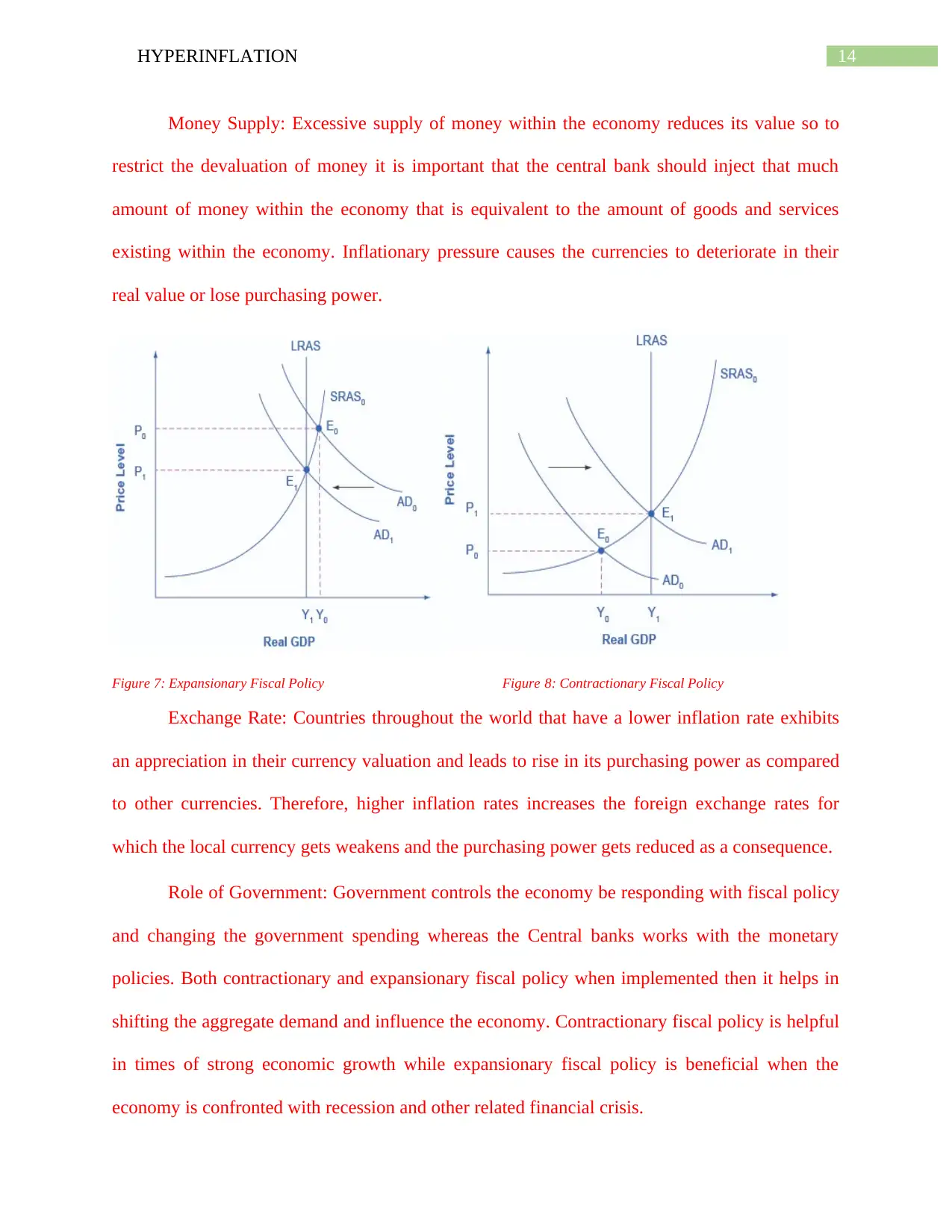
14HYPERINFLATION
Money Supply: Excessive supply of money within the economy reduces its value so to
restrict the devaluation of money it is important that the central bank should inject that much
amount of money within the economy that is equivalent to the amount of goods and services
existing within the economy. Inflationary pressure causes the currencies to deteriorate in their
real value or lose purchasing power.
Figure 7: Expansionary Fiscal Policy Figure 8: Contractionary Fiscal Policy
Exchange Rate: Countries throughout the world that have a lower inflation rate exhibits
an appreciation in their currency valuation and leads to rise in its purchasing power as compared
to other currencies. Therefore, higher inflation rates increases the foreign exchange rates for
which the local currency gets weakens and the purchasing power gets reduced as a consequence.
Role of Government: Government controls the economy be responding with fiscal policy
and changing the government spending whereas the Central banks works with the monetary
policies. Both contractionary and expansionary fiscal policy when implemented then it helps in
shifting the aggregate demand and influence the economy. Contractionary fiscal policy is helpful
in times of strong economic growth while expansionary fiscal policy is beneficial when the
economy is confronted with recession and other related financial crisis.
Money Supply: Excessive supply of money within the economy reduces its value so to
restrict the devaluation of money it is important that the central bank should inject that much
amount of money within the economy that is equivalent to the amount of goods and services
existing within the economy. Inflationary pressure causes the currencies to deteriorate in their
real value or lose purchasing power.
Figure 7: Expansionary Fiscal Policy Figure 8: Contractionary Fiscal Policy
Exchange Rate: Countries throughout the world that have a lower inflation rate exhibits
an appreciation in their currency valuation and leads to rise in its purchasing power as compared
to other currencies. Therefore, higher inflation rates increases the foreign exchange rates for
which the local currency gets weakens and the purchasing power gets reduced as a consequence.
Role of Government: Government controls the economy be responding with fiscal policy
and changing the government spending whereas the Central banks works with the monetary
policies. Both contractionary and expansionary fiscal policy when implemented then it helps in
shifting the aggregate demand and influence the economy. Contractionary fiscal policy is helpful
in times of strong economic growth while expansionary fiscal policy is beneficial when the
economy is confronted with recession and other related financial crisis.
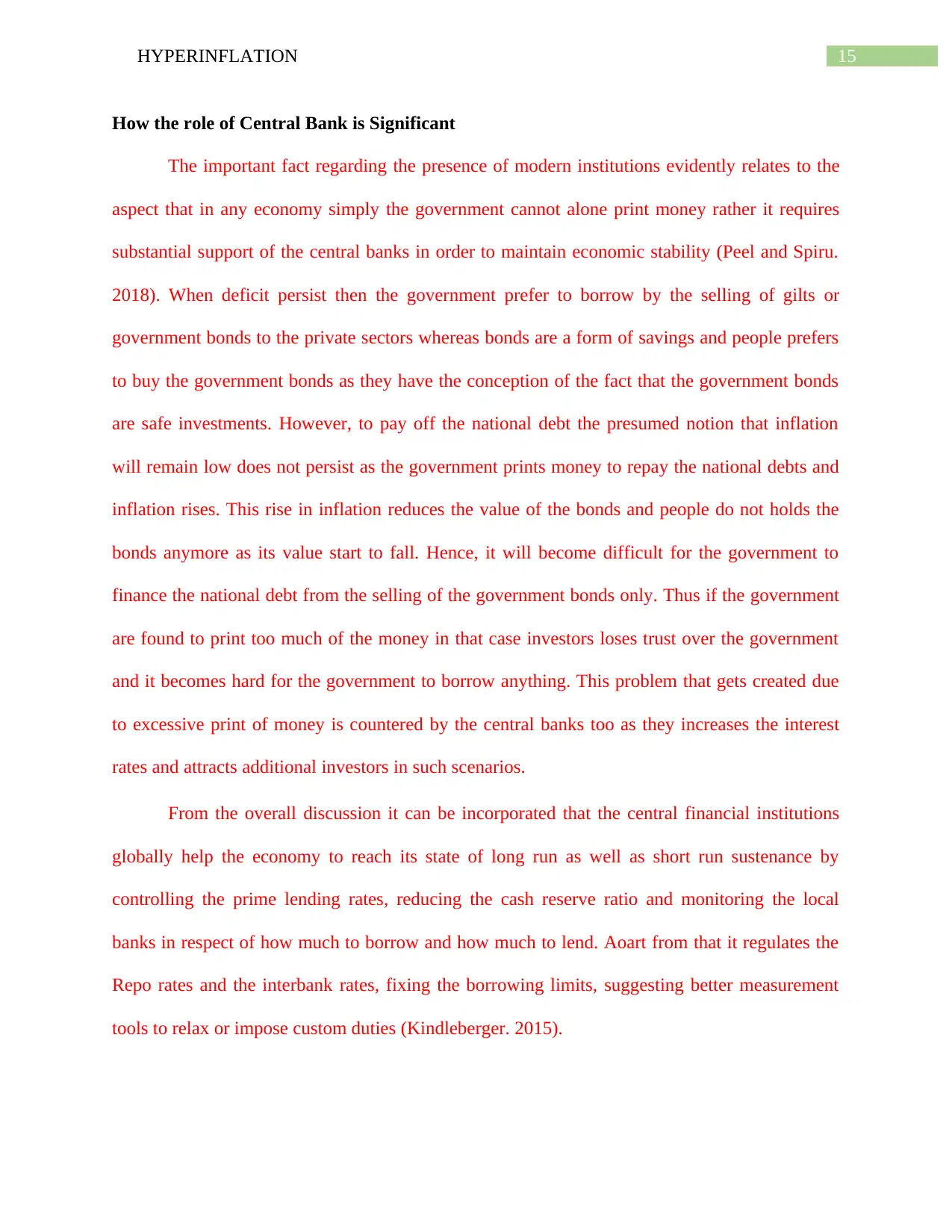
15HYPERINFLATION
How the role of Central Bank is Significant
The important fact regarding the presence of modern institutions evidently relates to the
aspect that in any economy simply the government cannot alone print money rather it requires
substantial support of the central banks in order to maintain economic stability (Peel and Spiru.
2018). When deficit persist then the government prefer to borrow by the selling of gilts or
government bonds to the private sectors whereas bonds are a form of savings and people prefers
to buy the government bonds as they have the conception of the fact that the government bonds
are safe investments. However, to pay off the national debt the presumed notion that inflation
will remain low does not persist as the government prints money to repay the national debts and
inflation rises. This rise in inflation reduces the value of the bonds and people do not holds the
bonds anymore as its value start to fall. Hence, it will become difficult for the government to
finance the national debt from the selling of the government bonds only. Thus if the government
are found to print too much of the money in that case investors loses trust over the government
and it becomes hard for the government to borrow anything. This problem that gets created due
to excessive print of money is countered by the central banks too as they increases the interest
rates and attracts additional investors in such scenarios.
From the overall discussion it can be incorporated that the central financial institutions
globally help the economy to reach its state of long run as well as short run sustenance by
controlling the prime lending rates, reducing the cash reserve ratio and monitoring the local
banks in respect of how much to borrow and how much to lend. Aoart from that it regulates the
Repo rates and the interbank rates, fixing the borrowing limits, suggesting better measurement
tools to relax or impose custom duties (Kindleberger. 2015).
How the role of Central Bank is Significant
The important fact regarding the presence of modern institutions evidently relates to the
aspect that in any economy simply the government cannot alone print money rather it requires
substantial support of the central banks in order to maintain economic stability (Peel and Spiru.
2018). When deficit persist then the government prefer to borrow by the selling of gilts or
government bonds to the private sectors whereas bonds are a form of savings and people prefers
to buy the government bonds as they have the conception of the fact that the government bonds
are safe investments. However, to pay off the national debt the presumed notion that inflation
will remain low does not persist as the government prints money to repay the national debts and
inflation rises. This rise in inflation reduces the value of the bonds and people do not holds the
bonds anymore as its value start to fall. Hence, it will become difficult for the government to
finance the national debt from the selling of the government bonds only. Thus if the government
are found to print too much of the money in that case investors loses trust over the government
and it becomes hard for the government to borrow anything. This problem that gets created due
to excessive print of money is countered by the central banks too as they increases the interest
rates and attracts additional investors in such scenarios.
From the overall discussion it can be incorporated that the central financial institutions
globally help the economy to reach its state of long run as well as short run sustenance by
controlling the prime lending rates, reducing the cash reserve ratio and monitoring the local
banks in respect of how much to borrow and how much to lend. Aoart from that it regulates the
Repo rates and the interbank rates, fixing the borrowing limits, suggesting better measurement
tools to relax or impose custom duties (Kindleberger. 2015).
Secure Best Marks with AI Grader
Need help grading? Try our AI Grader for instant feedback on your assignments.
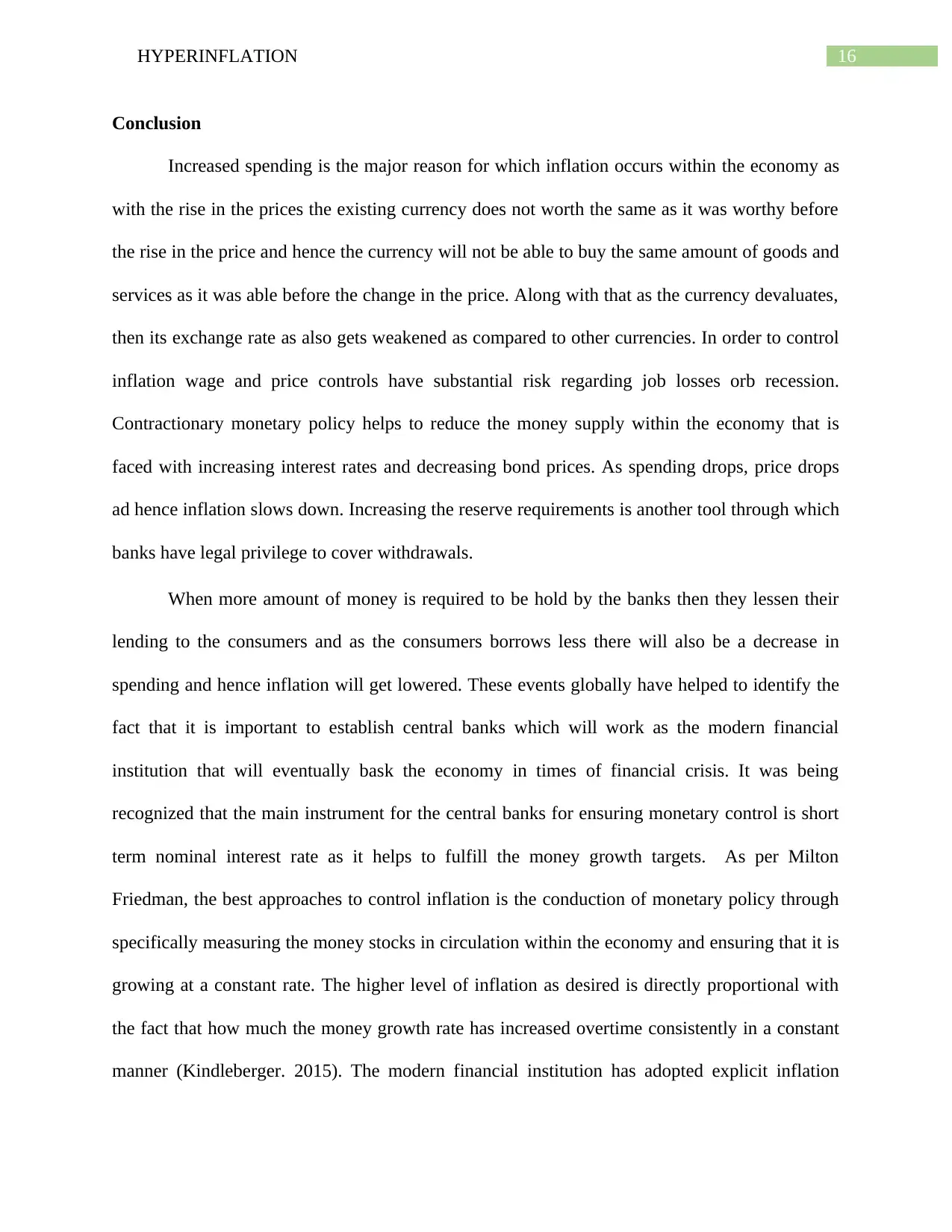
16HYPERINFLATION
Conclusion
Increased spending is the major reason for which inflation occurs within the economy as
with the rise in the prices the existing currency does not worth the same as it was worthy before
the rise in the price and hence the currency will not be able to buy the same amount of goods and
services as it was able before the change in the price. Along with that as the currency devaluates,
then its exchange rate as also gets weakened as compared to other currencies. In order to control
inflation wage and price controls have substantial risk regarding job losses orb recession.
Contractionary monetary policy helps to reduce the money supply within the economy that is
faced with increasing interest rates and decreasing bond prices. As spending drops, price drops
ad hence inflation slows down. Increasing the reserve requirements is another tool through which
banks have legal privilege to cover withdrawals.
When more amount of money is required to be hold by the banks then they lessen their
lending to the consumers and as the consumers borrows less there will also be a decrease in
spending and hence inflation will get lowered. These events globally have helped to identify the
fact that it is important to establish central banks which will work as the modern financial
institution that will eventually bask the economy in times of financial crisis. It was being
recognized that the main instrument for the central banks for ensuring monetary control is short
term nominal interest rate as it helps to fulfill the money growth targets. As per Milton
Friedman, the best approaches to control inflation is the conduction of monetary policy through
specifically measuring the money stocks in circulation within the economy and ensuring that it is
growing at a constant rate. The higher level of inflation as desired is directly proportional with
the fact that how much the money growth rate has increased overtime consistently in a constant
manner (Kindleberger. 2015). The modern financial institution has adopted explicit inflation
Conclusion
Increased spending is the major reason for which inflation occurs within the economy as
with the rise in the prices the existing currency does not worth the same as it was worthy before
the rise in the price and hence the currency will not be able to buy the same amount of goods and
services as it was able before the change in the price. Along with that as the currency devaluates,
then its exchange rate as also gets weakened as compared to other currencies. In order to control
inflation wage and price controls have substantial risk regarding job losses orb recession.
Contractionary monetary policy helps to reduce the money supply within the economy that is
faced with increasing interest rates and decreasing bond prices. As spending drops, price drops
ad hence inflation slows down. Increasing the reserve requirements is another tool through which
banks have legal privilege to cover withdrawals.
When more amount of money is required to be hold by the banks then they lessen their
lending to the consumers and as the consumers borrows less there will also be a decrease in
spending and hence inflation will get lowered. These events globally have helped to identify the
fact that it is important to establish central banks which will work as the modern financial
institution that will eventually bask the economy in times of financial crisis. It was being
recognized that the main instrument for the central banks for ensuring monetary control is short
term nominal interest rate as it helps to fulfill the money growth targets. As per Milton
Friedman, the best approaches to control inflation is the conduction of monetary policy through
specifically measuring the money stocks in circulation within the economy and ensuring that it is
growing at a constant rate. The higher level of inflation as desired is directly proportional with
the fact that how much the money growth rate has increased overtime consistently in a constant
manner (Kindleberger. 2015). The modern financial institution has adopted explicit inflation
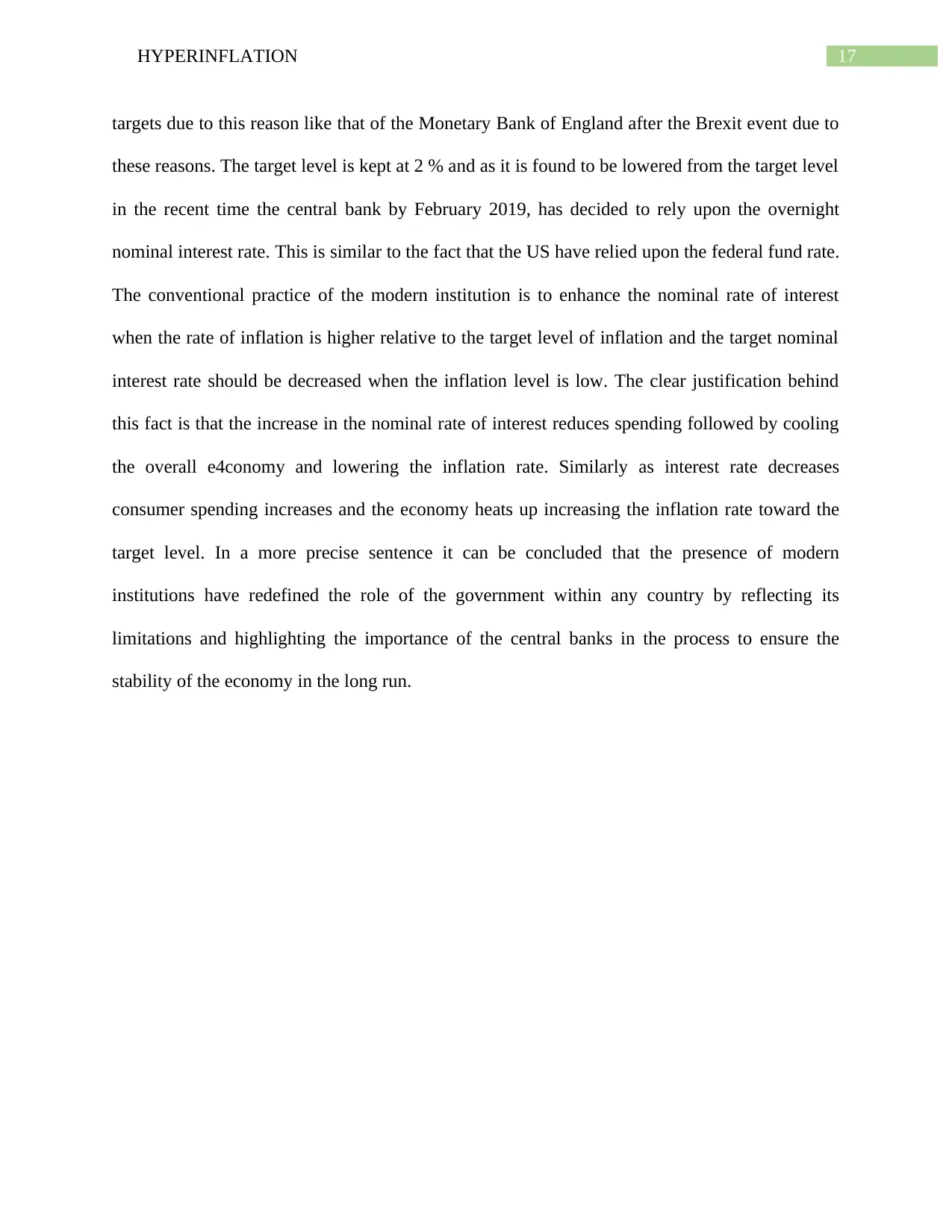
17HYPERINFLATION
targets due to this reason like that of the Monetary Bank of England after the Brexit event due to
these reasons. The target level is kept at 2 % and as it is found to be lowered from the target level
in the recent time the central bank by February 2019, has decided to rely upon the overnight
nominal interest rate. This is similar to the fact that the US have relied upon the federal fund rate.
The conventional practice of the modern institution is to enhance the nominal rate of interest
when the rate of inflation is higher relative to the target level of inflation and the target nominal
interest rate should be decreased when the inflation level is low. The clear justification behind
this fact is that the increase in the nominal rate of interest reduces spending followed by cooling
the overall e4conomy and lowering the inflation rate. Similarly as interest rate decreases
consumer spending increases and the economy heats up increasing the inflation rate toward the
target level. In a more precise sentence it can be concluded that the presence of modern
institutions have redefined the role of the government within any country by reflecting its
limitations and highlighting the importance of the central banks in the process to ensure the
stability of the economy in the long run.
targets due to this reason like that of the Monetary Bank of England after the Brexit event due to
these reasons. The target level is kept at 2 % and as it is found to be lowered from the target level
in the recent time the central bank by February 2019, has decided to rely upon the overnight
nominal interest rate. This is similar to the fact that the US have relied upon the federal fund rate.
The conventional practice of the modern institution is to enhance the nominal rate of interest
when the rate of inflation is higher relative to the target level of inflation and the target nominal
interest rate should be decreased when the inflation level is low. The clear justification behind
this fact is that the increase in the nominal rate of interest reduces spending followed by cooling
the overall e4conomy and lowering the inflation rate. Similarly as interest rate decreases
consumer spending increases and the economy heats up increasing the inflation rate toward the
target level. In a more precise sentence it can be concluded that the presence of modern
institutions have redefined the role of the government within any country by reflecting its
limitations and highlighting the importance of the central banks in the process to ensure the
stability of the economy in the long run.
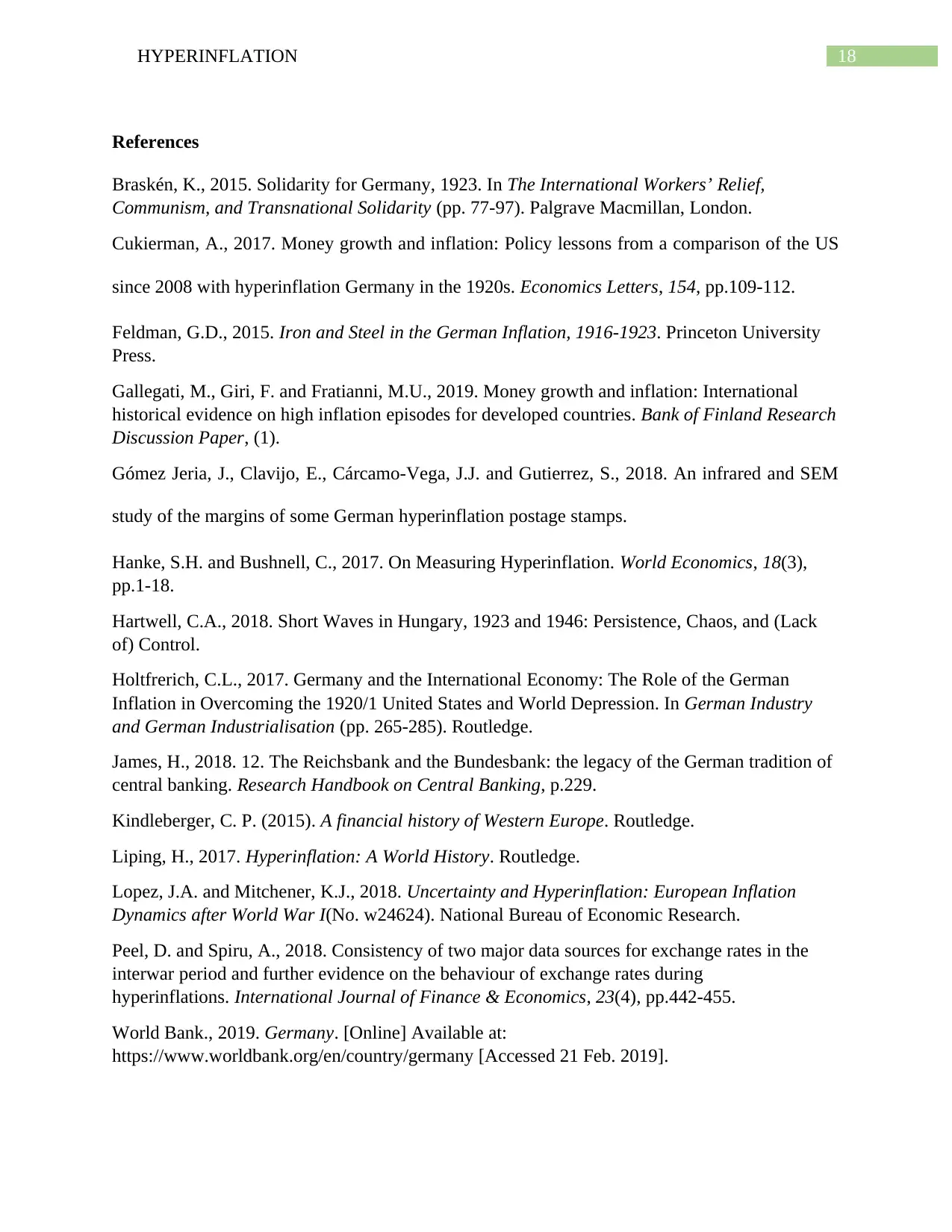
18HYPERINFLATION
References
Braskén, K., 2015. Solidarity for Germany, 1923. In The International Workers’ Relief,
Communism, and Transnational Solidarity (pp. 77-97). Palgrave Macmillan, London.
Cukierman, A., 2017. Money growth and inflation: Policy lessons from a comparison of the US
since 2008 with hyperinflation Germany in the 1920s. Economics Letters, 154, pp.109-112.
Feldman, G.D., 2015. Iron and Steel in the German Inflation, 1916-1923. Princeton University
Press.
Gallegati, M., Giri, F. and Fratianni, M.U., 2019. Money growth and inflation: International
historical evidence on high inflation episodes for developed countries. Bank of Finland Research
Discussion Paper, (1).
Gómez Jeria, J., Clavijo, E., Cárcamo-Vega, J.J. and Gutierrez, S., 2018. An infrared and SEM
study of the margins of some German hyperinflation postage stamps.
Hanke, S.H. and Bushnell, C., 2017. On Measuring Hyperinflation. World Economics, 18(3),
pp.1-18.
Hartwell, C.A., 2018. Short Waves in Hungary, 1923 and 1946: Persistence, Chaos, and (Lack
of) Control.
Holtfrerich, C.L., 2017. Germany and the International Economy: The Role of the German
Inflation in Overcoming the 1920/1 United States and World Depression. In German Industry
and German Industrialisation (pp. 265-285). Routledge.
James, H., 2018. 12. The Reichsbank and the Bundesbank: the legacy of the German tradition of
central banking. Research Handbook on Central Banking, p.229.
Kindleberger, C. P. (2015). A financial history of Western Europe. Routledge.
Liping, H., 2017. Hyperinflation: A World History. Routledge.
Lopez, J.A. and Mitchener, K.J., 2018. Uncertainty and Hyperinflation: European Inflation
Dynamics after World War I(No. w24624). National Bureau of Economic Research.
Peel, D. and Spiru, A., 2018. Consistency of two major data sources for exchange rates in the
interwar period and further evidence on the behaviour of exchange rates during
hyperinflations. International Journal of Finance & Economics, 23(4), pp.442-455.
World Bank., 2019. Germany. [Online] Available at:
https://www.worldbank.org/en/country/germany [Accessed 21 Feb. 2019].
References
Braskén, K., 2015. Solidarity for Germany, 1923. In The International Workers’ Relief,
Communism, and Transnational Solidarity (pp. 77-97). Palgrave Macmillan, London.
Cukierman, A., 2017. Money growth and inflation: Policy lessons from a comparison of the US
since 2008 with hyperinflation Germany in the 1920s. Economics Letters, 154, pp.109-112.
Feldman, G.D., 2015. Iron and Steel in the German Inflation, 1916-1923. Princeton University
Press.
Gallegati, M., Giri, F. and Fratianni, M.U., 2019. Money growth and inflation: International
historical evidence on high inflation episodes for developed countries. Bank of Finland Research
Discussion Paper, (1).
Gómez Jeria, J., Clavijo, E., Cárcamo-Vega, J.J. and Gutierrez, S., 2018. An infrared and SEM
study of the margins of some German hyperinflation postage stamps.
Hanke, S.H. and Bushnell, C., 2017. On Measuring Hyperinflation. World Economics, 18(3),
pp.1-18.
Hartwell, C.A., 2018. Short Waves in Hungary, 1923 and 1946: Persistence, Chaos, and (Lack
of) Control.
Holtfrerich, C.L., 2017. Germany and the International Economy: The Role of the German
Inflation in Overcoming the 1920/1 United States and World Depression. In German Industry
and German Industrialisation (pp. 265-285). Routledge.
James, H., 2018. 12. The Reichsbank and the Bundesbank: the legacy of the German tradition of
central banking. Research Handbook on Central Banking, p.229.
Kindleberger, C. P. (2015). A financial history of Western Europe. Routledge.
Liping, H., 2017. Hyperinflation: A World History. Routledge.
Lopez, J.A. and Mitchener, K.J., 2018. Uncertainty and Hyperinflation: European Inflation
Dynamics after World War I(No. w24624). National Bureau of Economic Research.
Peel, D. and Spiru, A., 2018. Consistency of two major data sources for exchange rates in the
interwar period and further evidence on the behaviour of exchange rates during
hyperinflations. International Journal of Finance & Economics, 23(4), pp.442-455.
World Bank., 2019. Germany. [Online] Available at:
https://www.worldbank.org/en/country/germany [Accessed 21 Feb. 2019].
Paraphrase This Document
Need a fresh take? Get an instant paraphrase of this document with our AI Paraphraser
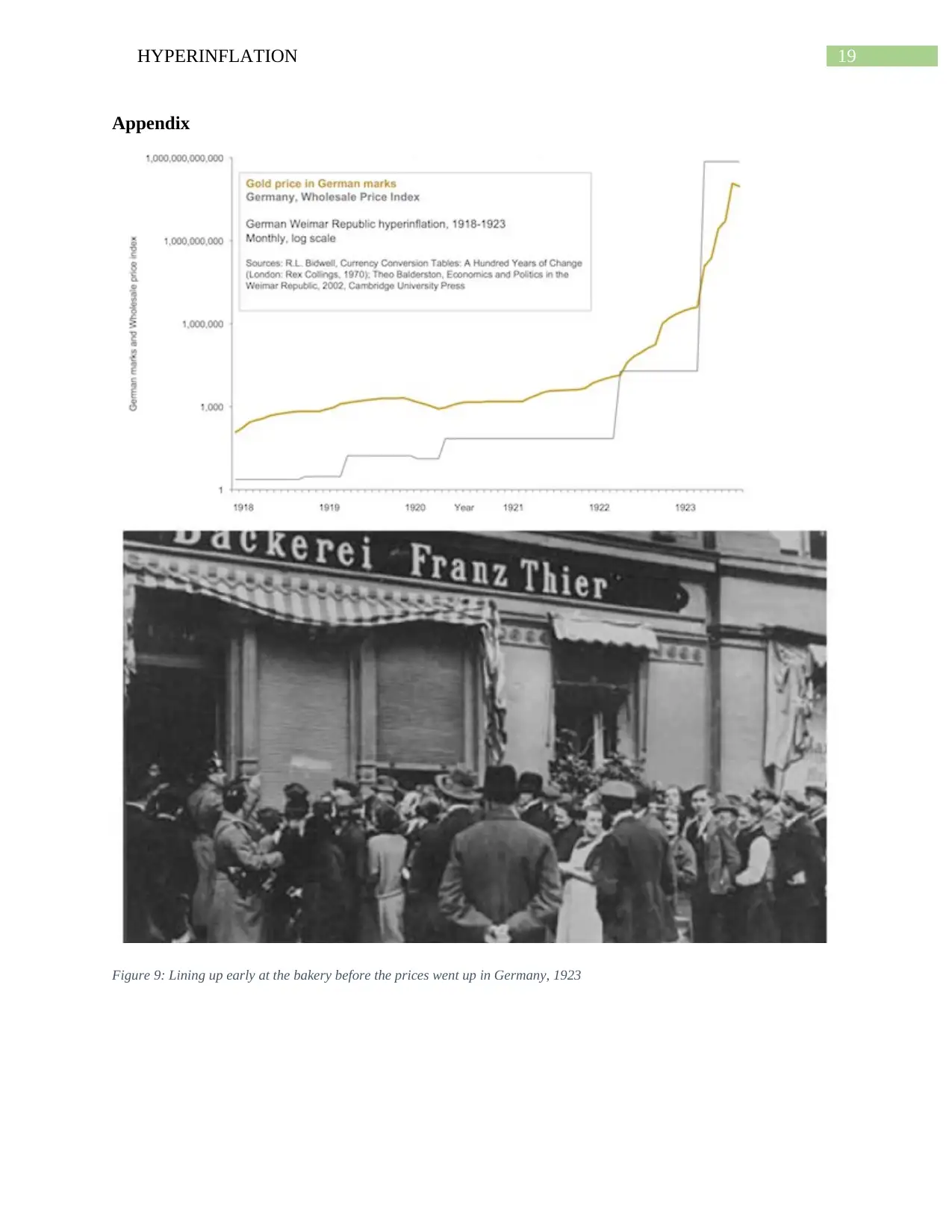
19HYPERINFLATION
Appendix
Figure 9: Lining up early at the bakery before the prices went up in Germany, 1923
Appendix
Figure 9: Lining up early at the bakery before the prices went up in Germany, 1923
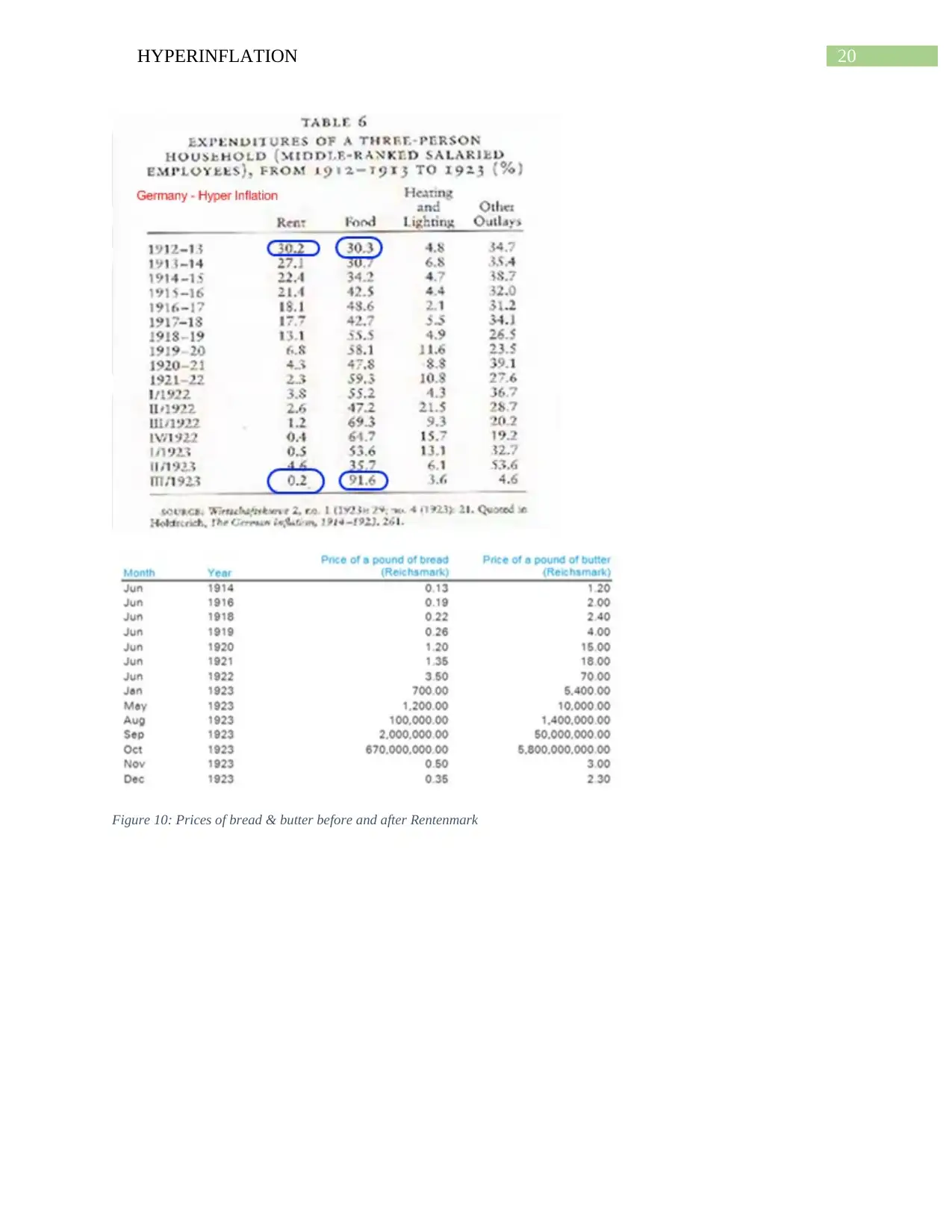
20HYPERINFLATION
Figure 10: Prices of bread & butter before and after Rentenmark
Figure 10: Prices of bread & butter before and after Rentenmark
1 out of 21
Related Documents
Your All-in-One AI-Powered Toolkit for Academic Success.
+13062052269
info@desklib.com
Available 24*7 on WhatsApp / Email
![[object Object]](/_next/static/media/star-bottom.7253800d.svg)
Unlock your academic potential
© 2024 | Zucol Services PVT LTD | All rights reserved.




